#eMobilityControls
Text
Autonomous Agricultural and Construction Vehicles
October 31, 2023
by dorleco
with no comment
Autonomous Vehicle Technology
Edit
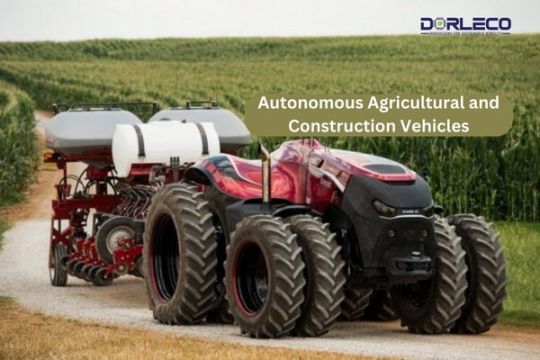
Introduction
A major technological leap in farming and building is represented by Autonomous Agricultural and Construction Vehicles. These cars can function with little assistance from humans because of their sophisticated sensors, GPS, and artificial intelligence systems. This article introduces these cutting-edge devices, summarizing their salient characteristics, advantages, and possible drawbacks of Autonomous Agricultural and Construction Vehicles.
Important Characteristics of Self-Driving Construction and Agricultural Equipment
Technology of Perception and Sensors: Autonomous cars can sense their surroundings thanks to a variety of sensors installed in them, including GPS, LiDAR, radar, and cameras. These sensors give the car real-time information about its surroundings, which aids with navigation and decision-making.
Artificial Intelligence (AI): AI systems analyze the sensor data and decide how to maneuver the vehicle, carry out tasks, and avoid obstacles. Over time, the vehicle’s decision-making abilities are frequently enhanced through the use of computer vision and machine learning.
GPS and Mapping: Accurate navigation requires high-precision GPS devices. Digital maps of the work area are frequently pre-programmed onto vehicles, enabling them to follow predetermined paths and carry out duties with remarkable accuracy.
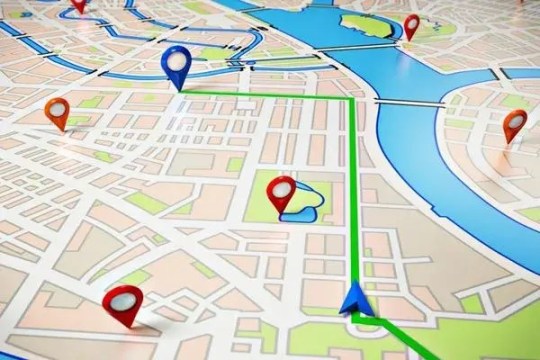
Remote Monitoring and Control: A lot of self-driving cars come with features that let their operators monitor and manage operations from a distance. This function improves safety and enables on-the-fly modifications in real time.
Interoperability: Autonomous vehicles can interact with other farm equipment and management systems in an agricultural setting to enable coordinated activities like planting, harvesting, and irrigation.
Safety Features: Safety is a top priority in the design of autonomous cars. To avoid collisions, they frequently have emergency stop systems and collision avoidance systems.
Advantages of Autonomous Agricultural and Construction Vehicles
The construction and agricultural industries stand to gain greatly from the many benefits that autonomous cars provide. The following are some of the main benefits:
Enhanced Productivity: Because autonomous cars can operate nonstop, they can accomplish tasks more quickly and with more efficiency. This is especially helpful in agriculture, where crop output depends on timely tasks like planting and harvesting.
Precision and Consistency: These vehicles follow predetermined routes and carry out jobs consistently, operating with a high degree of precision. Increased crop productivity, higher-quality building, and more efficient use of resources are all possible outcomes of this precision.
Cost Savings: Since autonomous cars require fewer human operators, labor costs may be lower in the long run. They use less fuel and resources because they run more effectively.
Operational Efficiency: Using information from sensors and AI algorithms, autonomous cars may instantly modify their course and optimize their routes. This flexibility leads to less waste and more effective use of resources.
Safety: Autonomous vehicles in the construction industry can carry out dangerous operations, such as excavation and demolition, without endangering human operators. They can lessen the physical strain on employees and assist in preventing field accidents in agriculture.
24/7 Operation: Since autonomous vehicles don’t need to sleep or take breaks, they can operate around the clock. This is especially useful at the most important times of the agricultural cycle.
Reduced Environmental Impact: By using resources like water and fertilizers more effectively, autonomous agricultural vehicles can lessen their negative effects on the environment and increase sustainability. Waste in construction can be decreased by optimizing resource use.
Data Gathering and Analysis: A multitude of data regarding the environment, agricultural conditions, and building sites can be gathered by these vehicles. To improve operations, long-term planning, and decision-making, this data can be evaluated.

Disadvantages of Autonomous Agricultural and Construction Vehicles
Although autonomous Agricultural and Construction Vehicles have many benefits, there are a number of drawbacks and difficulties that must be taken into account when putting this technology into practice. The following are some of the main drawbacks:
High Initial Costs: The acquisition and assimilation of self-driving cars and related technologies might be costly, potentially impeding their widespread use, particularly in small and medium-sized enterprises.
Maintenance and Repairs: Because autonomous cars are intricate machinery, they occasionally need professional personnel for repairs in addition to routine maintenance. When compared to conventional vehicles or equipment, maintenance expenses may be higher.
Liability and Legal Issues: Determining who is responsible for accidents or mistakes involving self-driving cars might be complicated, necessitating modifications to existing legal frameworks. It might be difficult to navigate the legal and regulatory environment.
Data security: A lot of data, including environmental and mapping data, is gathered and sent by autonomous cars. To stop misuse, hacking, or theft, it is essential to protect the security and privacy of this data.

Job Displacement: In industries where labor has historically been needed, the use of autonomous cars may result in employment displacement. It will be difficult to manage the social and economic effects of this relocation.
Technological Restrictions: Because autonomous cars rely on a variety of sensors and technology, they could have trouble operating in inclement weather, dimly lit areas, or challenging terrain. Restrictions imposed by technology may hinder their performance.
Human Oversight and Intervention: The ability of autonomous cars to function fully independently may be limited if they still need human supervision to manage difficult or unexpected scenarios.
Adaptation and Training: To properly operate, monitor, and maintain autonomous vehicles, personnel and operators may need to complete training. It may require some time and effort to become used to this new technology.
Conclusion:
In conclusion, autonomous agricultural and construction vehicles represent a transformative leap forward in the fields of farming and construction. These vehicles offer a wide array of benefits, including increased productivity, precision, cost savings, and enhanced safety. They have the potential to revolutionize the way we approach tasks in these industries, making them more efficient, sustainable, and safe.
However, their adoption is not without challenges. High initial costs, regulatory complexities, maintenance requirements, and potential job displacement are factors that must be carefully considered. These challenges emphasize the need for a strategic approach to implementation and a focus on long-term planning.
Despite these challenges, the advantages of autonomous vehicles cannot be overlooked. As technology continues to advance and regulations catch up, the integration of autonomous agricultural and construction vehicles is likely to become more widespread. The key will be to balance the advantages with the disadvantages and mitigate potential risks effectively.
In the coming years, as technology evolves and becomes more accessible, autonomous agricultural and construction vehicles have the potential to drive significant improvements in efficiency, safety, and sustainability, ultimately benefiting both businesses and the broader society. It is a promising path towards a future where we achieve more with less, while also ensuring that our agricultural and construction industries remain competitive and environmentally responsible.
#Autonomouscontrols#Agriculturalvehicles#ConstructionVehicles#selfdrivingcars#KeylessEntry#Cybersecurity#StartSystems#dorleco#controlsystem#ADAS#eMobilityControls#AVRescueProtocols#automotive#controlunit
0 notes
Text
Autonomous Vehicle Software
October 30, 2023
by dorleco
with no comment
Autonomous Vehicle Technology
Edit
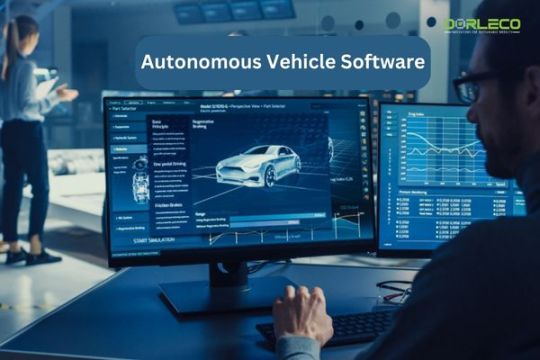
Introduction:
Self-driving cars, also known as autonomous vehicles, have quickly gained popularity as a ground-breaking technology that has the potential to completely change transportation. Modern software systems installed in these cars allow them to navigate and function on the road without the need for human assistance. In this overview of autonomous car software, we’ll look at the main elements, difficulties, and developments in the field of autonomous technology.
Essential Elements of Software for Autonomous Vehicles:
The software for autonomous vehicles is a complex system made up of various essential parts:
Perception: To sense its surroundings, the car’s perception system uses sensors including cameras, radar, LiDAR, and ultrasonic sensors. These sensors gather information about the environment around the car, such as other cars, people walking, traffic lights, and the state of the road.
Localization: The car needs localization in order to comprehend its exact location on the road. For precise localization, inertial measuring units (IMUs), GPS, and map data are utilized.
Mapping: Autonomous cars require high-definition maps. The vehicle is able to make educated decisions because of these maps, which offer comprehensive information about traffic signs, lane markings, and road layout.
Control: To make driving judgments in real-time, the control system analyzes data from perception, localization, and mapping. For safe navigation, it regulates the car’s braking, steering, and acceleration.
Planning and Decision-Making: Based on maps and the observed surroundings, the planning module creates a route for the vehicle, and the decision-making part weighs the pros and cons of each option before choosing the safest and most effective course of action.
Developments in Autonomous Vehicle Software:
The field of autonomous vehicle software has made significant strides recently, with important developments occurring in the following areas:
AI and machine learning: Algorithms for machine learning are enhancing the vision and judgment of self-driving cars, allowing them to take in information from the actual world and adjust to novel circumstances.
Simulation: By enabling developers to test and validate autonomous software in a variety of scenarios, extensive simulation environments can eliminate the requirement for in-person testing.
Connectivity: By sharing data with other cars, the traffic system, and pedestrians, autonomous vehicles can improve efficiency and safety through V2X (vehicle-to-everything) connectivity.
Over-the-Air (OTA) Updates: By addressing security flaws and enhancing performance, OTA software updates enable autonomous cars to receive regular software upgrades.

Pros of Autonomous Vehicle Software
Self-driving car software, or autonomous vehicle software, has several potential advantages and benefits. These advantages have the power to completely transform transportation while also boosting efficiency and safety. The following are a few of the main advantages of autonomous car software:
Increased Safety: Autonomous vehicles have the potential to drastically lower the frequency of collisions brought on by driver error, including speeding, distracted driving, and driving under the influence. Accidents may be reduced as a result of the software’s ability to obey traffic laws, keep safe distances, and make prompt, accurate decisions.
Reduced Traffic Congestion: By interacting with traffic infrastructure and one another, autonomous cars can improve traffic flow. This can lessen traffic congestion by easing blockages and increasing the general effectiveness of transportation networks.
Enhanced Accessibility: People with impairments, the elderly, and those unable to drive due to medical conditions may have more mobility thanks to autonomous vehicles. Their freedom and quality of life may both be greatly enhanced by this.
Environmental Benefits: Fuel economy and pollution can be optimized by programming autonomous cars. Air pollution and greenhouse gas emissions may decline in the future as a result of the switch to electric and driverless vehicles.
Reduced Parking Demand: Autonomous vehicles that can park and drop off people can lessen the need for parking spots in cities, utilizing valuable real estate more wisely.
Time savings: Traveling in an autonomous car allows passengers to make better use of their time. For commuters, this may result in higher output as well as better relaxation and lower stress levels.
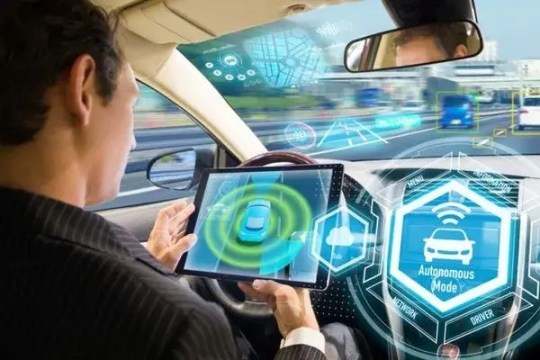
Economic Benefits: From software development to vehicle maintenance, the development and implementation of autonomous cars have the potential to provide jobs across a range of industries. It can also help sectors like delivery services and ride-sharing.
Enhanced Mobility Services: On-demand, shared mobility services can be made possible by autonomous technology, which will save customers money and increase the convenience of transportation. Additionally, it may lessen the necessity for individual car ownership.
Cons of Autonomous Vehicle Software
Although autonomous car software has a lot of potential advantages, there are a number of issues and problems that need to be resolved. The following are some drawbacks and issues with software for autonomous vehicles:
Safety and Reliability: Despite advancements, questions remain regarding the dependability and safety of autonomous cars. Ongoing difficulties include technology malfunctions, software bugs, and the capacity to manage complicated and unforeseen circumstances.
High Development Costs: The process of creating and testing software for autonomous vehicles is costly and resource-intensive. For many businesses, this expense can be a barrier to entry, which could lead to higher car prices.
Cyberattack vulnerability: Software and data transmission play a major role in autonomous cars. They become more susceptible to cyberattacks as a result, endangering their security and safety. One of the main concerns is being protected from cyber dangers.

Legal and Regulatory Difficulties: The laws and regulations pertaining to self-driving cars are constantly changing. It can be difficult to determine who is responsible for accidents or software malfunctions, which could impede the use of the technology.
Job displacement: As autonomous vehicles become more widely used, jobs in sectors including delivery, cab services, and haulage may be lost, thereby disrupting the economy and displacing drivers.
Ethical Dilemmas: In the event of an imminent collision, autonomous cars may have to decide between protecting pedestrians and the people in the vehicle, for example. Solving these moral conundrums is a difficult task.
Privacy Concerns: A lot of data, including location and passenger personal information, is collected and stored by autonomous cars. To stop abuse or breaches, data privacy and security must be guaranteed.
Limited Accessibility: Due to the high expense of autonomous technology, some socioeconomic groups may not be able to use it, which could lead to unequal access to transportation options.
Conclusion:
In conclusion, autonomous vehicle software represents a transformative technology that holds the promise of revolutionizing transportation and mobility. While the benefits are substantial, including improved safety, reduced traffic congestion, enhanced accessibility, and environmental advantages, it’s essential to recognize the challenges and concerns associated with this technology.
Safety and reliability, high development costs, cyber vulnerabilities, legal and regulatory hurdles, job displacement, ethical dilemmas, and privacy issues are among the significant cons that must be addressed as autonomous vehicles continue to evolve. Additionally, the impact on the job market and the potential for job displacement in transportation-related industries are subjects of concern that merit careful consideration.
The ongoing research, development, and collaboration among government agencies, industry stakeholders, and academia are crucial in overcoming these challenges and ensuring the responsible integration of autonomous vehicles into our transportation systems. Regulatory frameworks are evolving, and safety measures are continuously improving, with a strong emphasis on data privacy, security, and ethical considerations.
As the technology matures and these concerns are addressed, the potential for safer, more efficient, and more accessible transportation systems becomes increasingly attainable. Autonomous vehicle software represents a pivotal chapter in the evolution of mobility, offering not only convenience and efficiency but also the prospect of enhancing the overall quality of life for people around the world. Its success will ultimately depend on the ability to strike a balance between innovation and addressing the associated challenges, with a focus on the safety and well-being of all road users.
#Autonomouscontrols#EmergencyResponse#selfdrivingcars#KeylessEntry#Cybersecurity#StartSystems#dorleco#controlsystem#ADAS#eMobilityControls#AVRescueProtocols#automotive#controlunit
0 notes
Text
Cyber security for Autonomous Vehicles
October 27, 2023
by dorleco
with no comment
Autonomous Vehicle Technology
Edit

Introduction:
In the automobile business, autonomous vehicles, sometimes known as self-driving cars, are a game-changing technological advancement. These automobiles have the power to improve travel conditions generally, lessen traffic, and raise road safety. But as a result of its incorporation into our roads, a whole new set of security issues have surfaced. An overview of Cyber security for Autonomous Vehicles will be given in this introduction, along with a focus on the significance of protecting these cutting-edge modes of transportation.
The Importance of Cyber Security for Autonomous Vehicles
Data-Driven Operation: In order to make judgments in real time, autonomous cars mostly rely on communication networks and data. Any loss of availability or integrity of data might have dire repercussions.
Safety Issues: Passengers’ and other drivers’ safety may be in danger if autonomous cars are compromised. Accidents can occur when sensors are manipulated or when the operations of the vehicle are controlled remotely.
Privacy Concerns: A lot of information about the whereabouts and actions of passengers is gathered by autonomous cars. To preserve privacy, this sensitive information must be protected.
Economic Impact: The market for autonomous cars is expected to reach $1 trillion. Cybersecurity breaches may disrupt this developing market, resulting in monetary losses and eroding public confidence.
Key Cyber Security Challenges:
Vehicular Networks: Through intricate networks, autonomous cars can interact with infrastructure and with one another. These networks must be secured in order to stop illegal access and data breaches.
Sensor Systems: LiDAR and cameras are two examples of sensors that are essential for perception and navigation. It is possible to trick the car using these sensors, which poses a risk to safety.

Software Vulnerabilities: The complex software systems that autonomous cars rely on could have flaws. Software security and patching are essential to preventing exploits.
Over-the-Air (OTA) Updates: OTA updates improve the security and functionality of vehicles. It is imperative to guarantee the validity and integrity of these updates.
Human-Machine Interface (HMI): Infotainment systems and other HMI components need to be secured against hacking attempts that can compromise the operation of cars.
Mitigating Cyber Security Risks:
Encryption: To avoid data theft and eavesdropping, data should be encrypted both while it is in transit and at rest.
Intrusion Detection Systems: Use cutting-edge intrusion detection technologies to keep an eye on network activity and spot irregularities.
Firmware Validation and Secure Boot: Make use of secure boot procedures to guarantee that the car’s systems are running only approved firmware.
Multi-Factor Authentication: Use strong authentication methods, such as multi-factor authentication, to gain access to car systems and data.
Collaboration and Regulation: Encourage cooperation between automakers, authorities, and cyber security professionals to create and implement industry standards and laws.
Advantages of Cybersecurity for Autonomous Vehicles
Numerous benefits are provided by cybersecurity for autonomous vehicles, which are essential for guaranteeing the dependable and safe functioning of these vehicles. These benefits are critical to the success and widespread acceptance of autonomous vehicle technology and the safety of both passengers and the broader public. The following are the main benefits of cybersecurity for self-driving cars:
1. Safety and Reliability:
Cybersecurity measures protect autonomous cars from malevolent cyberattacks, preventing the compromise of their vital operational systems. This improves safety by reducing the possibility of unwanted access, data theft, or manipulation of vehicle functionality.
Avoiding Accidents: Cybersecurity precautions might lessen the likelihood of mishaps brought on by hacking into car controls or sensors. Ensuring the accuracy of decisions and preventing collisions requires safeguarding the integrity of sensor data and communication systems.
2. Data Privacy:
Safeguarding Personal Information: Autonomous cars collect a tonne of information about the whereabouts and activities of their occupants. Passenger privacy is preserved via effective cybersecurity, which guarantees that this sensitive information is kept private.
Adherence to Data Regulations: With data privacy laws such as the CCPA and GDPR in force, it is imperative to guarantee the security of personal information in autonomous cars in order to prevent legal ramifications.
3. Maintaining Public Trust:
Building Confidence: Maintaining Public Trust in a strong cyber security framework fosters public, manufacturer, and passenger trust. If passengers feel that their privacy and safety are guaranteed, they are more likely to accept autonomous vehicles.
Maintaining Reputation: Manufacturers of autonomous vehicles and the technology in general risk having their good name damaged by a single cyber security incident. Robust cyber security safeguards the industry’s reputation.
4. Preventing Financial Loss:
Safeguarding Investments: The automobile industry, manufacturers, and stakeholders have to make substantial investments in autonomous vehicles. By averting security breaches and the resulting financial losses, cyber security contributes to the protection of these investments.
Liabilities Reduction: Cyber security for Autonomous Vehicles measures might lessen the possibility of legal ramifications from autonomous vehicle-related accidents or privacy violations.
5. Meeting Industry Standards:
Complying with Regulations: The development and implementation of autonomous cars require adherence to cybersecurity standards and regulations. Government agencies and business associations frequently demand adherence to these criteria.
Reducing Regulatory Barriers: Good Cyber security for Autonomous Vehicles procedures can make it easier for producers of autonomous vehicles to comply with regulatory regulations, hastening the commercialization of the technology.
6. Secure Updates:
Over-the-air Updates: Over-the-air (OTA) updates are frequently used in autonomous vehicles. Cybersecurity makes sure these upgrades are safe and uncheckable. This stops software vulnerabilities and illegal changes.

7. Continuous Improvement:
Adaptability: Because cybersecurity is dynamic, it must constantly evolve to meet new threats. Cybersecurity procedures for autonomous vehicles allow for continuous improvement and tinkering with security protocols.
Disadvantages of Cyber Security for Autonomous Vehicles
Although Cyber security for Autonomous Vehicles is crucial for self-driving cars, putting these precautions in place has significant drawbacks and difficulties. To successfully address and minimize these difficulties, awareness of them is essential. The following are a few drawbacks of cybersecurity for self-driving cars:
Cost and Complexity: Putting strong cybersecurity safeguards in place can be expensive and time-consuming. The cost of developing autonomous vehicles may go up as a result of the substantial financial and human resources needed to create, maintain, and update security systems and protocols.
Performance Impact: There may be a performance cost associated with certain cybersecurity solutions, such as intrusion detection systems and encryption. This may have an impact on autonomous cars’ ability to make decisions in real time, which could cause delays in reacting to urgent circumstances.
Negatives/False Positives: Intrusion detection systems might mistakenly identify genuine threats or produce false alerts. This can be a big problem because ignored threats might have serious repercussions, and false alarms can cause needless interventions or service interruptions.
Regulatory Compliance: Although following regulations is necessary to guarantee a minimal level of security, it might be difficult to do so. It can be difficult for manufacturers to comply with various regional standards and laws when they change.
Resource Constraints: In the autonomous vehicle sector, smaller or newly established businesses may find it difficult to set aside enough funds for effective cybersecurity procedures. This may cause their cars to have security flaws.
User Experience: The user experience may suffer from overly stringent cybersecurity measures. Passengers may become irritated and discouraged from using autonomous vehicles as a result of overly stringent security procedures, such as frequent identification reminders.
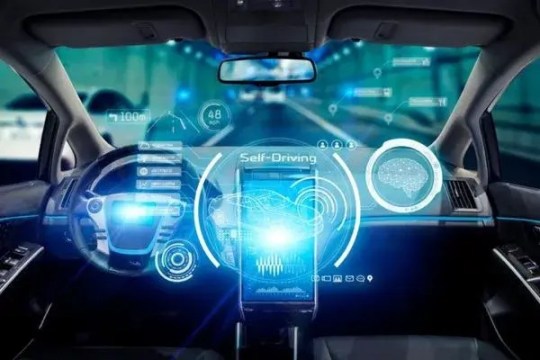
Interoperability Problems: It can be difficult to make sure that different autonomous car systems and parts are interoperable with one another and follow cybersecurity guidelines. Vulnerabilities resulting from incompatibilities could be exploited by attackers.
Conclusion:
In conclusion, Cyber security for Autonomous Vehicles is a critical and evolving field that plays a pivotal role in the successful integration of self-driving cars into our transportation systems. The advantages of robust cybersecurity measures, including safety, data privacy, public trust, financial protection, regulatory compliance, and the facilitation of secure over-the-air updates, are significant and far-reaching. These advantages not only safeguard passengers and the public but also contribute to the continued growth and success of the autonomous vehicle industry.
However, it is equally important to acknowledge the challenges and disadvantages associated with implementing Cyber security for Autonomous Vehicles. These challenges, such as increased complexity and cost, potential performance impacts, and the need to strike a delicate balance between innovation and security, underscore the need for a comprehensive and adaptable approach to cybersecurity.
Addressing these challenges requires collaboration among autonomous vehicle manufacturers, cybersecurity experts, regulators, and stakeholders. It necessitates ongoing research and development to stay ahead of evolving threats and vulnerabilities. Moreover, it emphasizes the importance of designing security measures that do not hinder the user experience but rather enhance it.
As autonomous vehicles become an integral part of our future transportation landscape, ensuring that they are secure from cyber threats is not just a technical concern but a social and ethical responsibility. By proactively addressing these challenges and leveraging the advantages of Cyber security for Autonomous Vehicles, we can pave the way for safer, more efficient, and more reliable autonomous vehicles that benefit society as a whole. Cybersecurity is the linchpin in this endeavor, providing the assurance that the promise of self-driving cars can be realized while minimizing the risks associated with them.
#Autonomouscontrols#EmergencyResponse#selfdrivingcars#KeylessEntry#Cybersecurity#StartSystems#dorleco#controlsystem#ADAS#eMobilityControls#AVRescueProtocols#automotive#controlunit
0 notes
Text
Autonomous Vehicle Simulation and Testing
October 26, 2023
by dorleco
with no comment
Autonomous Vehicle Technology
Edit

Introduction
Autonomous vehicles, sometimes known as self-driving automobiles, are a revolutionary development in the auto sector. These cars could improve accessibility, efficiency, and safety in transportation. To assure their safety and dependability, they must first go through thorough modeling and testing before being used on a big scale. This introduction gives a general overview of the Autonomous Vehicle Simulation and Testing while emphasizing their significance, essential elements, and difficulties.
1. Importance of Autonomous Vehicle Simulation and Testing:
Safety Assurance: It is crucial to guarantee the safety of autonomous cars. Testing and simulation offer a controlled environment to find and fix potential system flaws, preventing accidents and preserving public confidence.
Regulatory Compliance: Autonomous cars are subject to strict regulatory requirements. Manufacturers can demonstrate compliance with these criteria with the aid of Autonomous Vehicle Simulation and Testing.
Cost-Efficiency: Testing under actual conditions can be expensive and time-consuming. Simulations enable rapid data collecting and cost-effective testing.
Performance Optimization: Autonomous vehicle systems can be improved for best performance, responsiveness, and dependability through Autonomous Vehicle Simulation and Testing.
2. Components of Autonomous Vehicle Simulation and Testing:
Sensor Simulation: Autonomous vehicles rely on a variety of sensors, including LiDAR, radar, cameras, and GPS. The responses of the vehicle to various events are evaluated by simulations that imitate sensor inputs.

Environment modeling: To simulate real-world situations such as traffic, pedestrians, and weather, virtual environments are constructed. This makes testing possible in a variety of difficult circumstances.
Behavioral Modeling: Simulation models the behavior of the vehicle, including course planning and collision avoidance, to assess its capacity for safe navigation.
Data Logging and Analysis: During simulations and tests, a large amount of data is collected, which is then examined to find potential problems, confirm system performance, and enhance algorithms.
3. Testing Types:
Hardware-in-the-Loop (HIL): The autonomous vehicle’s hardware components, such as sensors and controllers, are evaluated in a simulated environment during Hardware-in-the-Loop (HIL) testing. As a result, early validation is possible without deploying the entire vehicle.
Software-in-the-loop (SIL): Software-in-the-loop (SIL) testing entails executing the software for an autonomous vehicle in a simulated setting. It evaluates the algorithms and decision-making processes used by the vehicle.
Vehicle-in-the-loop (VIL): Vehicle-in-the-loop (VIL) is a method for simulating traffic and environments while using actual automobiles. This strategy creates a link between simulation and practical testing.
Real-World Testing: To verify system performance once the Autonomous Vehicle Simulation and Testing in safe environments are successful, real-world testing is carried out on closed rails and open highways.
4. Challenges:
Realism: High levels of realism in simulations can be difficult to achieve. Simulated settings must faithfully reflect actual environmental conditions.
Scenario Diversity: It is crucial to test autonomous vehicles in a variety of situations, including uncommon and edge instances that can be challenging to thoroughly replicate.
Regulatory Framework: The process of creating a precise regulatory framework for the certification and testing of autonomous vehicles is one that is both difficult and dynamic.
Cybersecurity: Because autonomous vehicles are susceptible to cyberattacks, security testing is an important step in the development process.
Pros of Autonomous Vehicle Simulation and Testing
The development and use of self-driving automobiles are made possible by the many benefits that autonomous vehicle simulation and testing provide. A few of the main benefits are as follows:
1. Safety Enhancement:
Autonomous vehicle modeling and testing offer a safe and controlled environment to spot and address potential security flaws. This reduces the risks linked to driverless vehicles.
2. Reduced Real-world Testing Costs:
Comparatively speaking to testing on actual roads, simulation testing is more economical. Development becomes more effective and inexpensive when costs for gasoline, maintenance, and the requirement for real test tracks are eliminated.
3. Scalability:
Engineers may assess an autonomous vehicle’s performance under a variety of settings and scenarios using simulations, which allows for quick scaling and eliminates the need for significant real-world testing.
4. Scenario Reproducibility:
Simulated environments make it simpler to compare results, validate improvements, and gauge how the vehicle will behave in various scenarios by precisely replicating scenarios and conditions.
5. Quick Iteration:
Engineering can quickly discover problems and take action to fix them thanks to simulation, which promotes more rapid development of hardware and software.
6. Data Collection and Analysis:
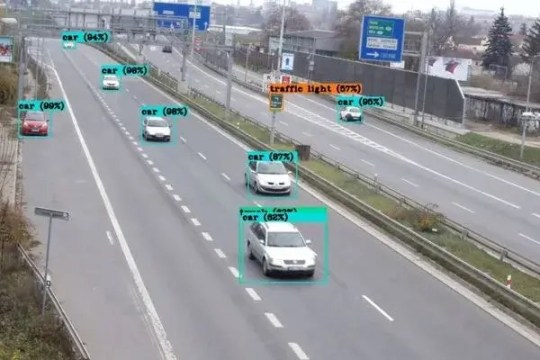
7. Privacy and Security:
Simulated testing lowers the danger of intellectual property theft and privacy violations by avoiding exposing sensitive information or proprietary technologies on public roads.
8. Versatility:
In order to conduct a thorough examination, simulations can reproduce a variety of driving situations, including extreme scenarios that are risky or difficult to replicate in real-world testing.
Cons of Autonomous Vehicle Simulation and Testing
Although testing and simulating autonomous vehicles has many benefits, there are some drawbacks and difficulties with these methods as well. The following are some drawbacks of testing and simulating autonomous vehicles:
1. Limited Realism:
Simulated settings might not always accurately reflect the complexity of actual environmental factors, which could pose problems for evaluating the performance of autonomous vehicles. Unrepresentative factors may include human drivers’ unpredictable behavior, unmodeled road dangers, and changes in infrastructure.
2. Overfitting:
Autonomous systems may underperform when exposed to unanticipated real-world settings if they have been fine-tuned primarily using simulation data.
3. Sensor Realism:
It’s possible that simulated sensor data won’t accurately reflect the nuances of real sensor inputs, which could cause differences between the system’s performance in simulation and in practice.
4. Incomplete Scenario Coverage:
Comprehensive scenario database creation can be a time-consuming and difficult undertaking for simulations. There is a chance of missing unusual but important circumstances that are essential for assessing the safety of an autonomous vehicle.
5. Simulation Uncertainty:
The reliability of test findings might be impacted by uncertainty and modeling mistakes in the simulation environment. If simulations are not thoroughly tested, this could create a false sense of security.
6. Hardware-in-the-Loop (HIL) Complexity:

7. Data and Processing Demands:
Massive volumes of data are produced during simulation, and this data needs to be stored, processed, and analyzed, which can be costly and resource-intensive.
8. Dynamic Traffic Interactions:
Due to their unpredictable nature and the requirement for high-fidelity modeling, real-time interactions with other road users, like as pedestrians, cyclists, and human drivers, can be difficult to simulate.
Conclusion:
In conclusion, autonomous vehicle simulation and testing are indispensable components of the development and deployment of self-driving cars. These processes play a pivotal role in enhancing the safety, reliability, and functionality of autonomous systems. While there are both pros and cons associated with these methods, their collective impact is overwhelmingly positive, shaping the future of transportation in significant ways.
However, it is important to acknowledge the challenges and limitations that come with Autonomous Vehicle Simulation and Testing, such as the need for realistic modeling, the risk of overfitting, and the complexity of edge cases. Real-world testing remains essential to validate the technology under unpredictable and complex conditions.
Balancing simulation with real-world testing is critical to achieving the necessary safety and reliability standards for autonomous vehicles. The ongoing development and integration of these methods will continue to play a central role in the future of transportation, paving the way for safer, more efficient, and more accessible Autonomous Vehicle Simulation and Testing.
#Autonomouscontrols#EmergencyResponse#selfdrivingcars#KeylessEntry#HybridVehicle#StartSystems#dorleco#controlsystem#ADAS#eMobilityControls#AVRescueProtocols#automotive#controlunit
0 notes
Text
Autonomous Vehicle Control
October 25, 2023
by dorleco
with no comment
Autonomous Vehicle Technology
Edit
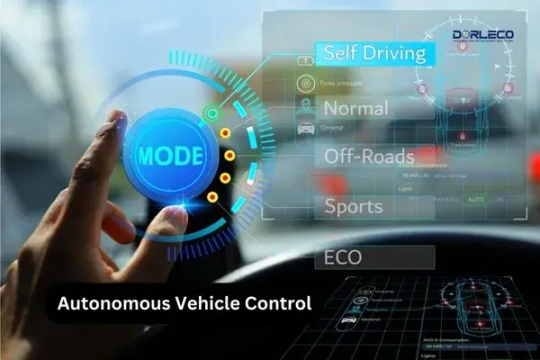
Introduction
Autonomous vehicles, often known as self-driving cars, are an innovative technology that has the potential to change the way we travel and how we conduct our daily lives. These vehicles use a combination of sensors, software, and control systems to make real-time driving decisions in a manner comparable to that of a human driver. They are built to navigate and run autonomously. We’ll look at the basic ideas and elements of autonomous vehicle control in this introduction.
1. Sensors:
Different types of sensors are included in autonomous cars, which provide them access to crucial data about their environment. These sensors consist of:
Lidar: Laser-based sensors that produce precise 3D representations of the surroundings of a moving object.
Radar: Radio waves are used by radar to measure an object’s distance and relative speed.
Cameras: Use cameras to take pictures and movies that can be used to identify other vehicles, traffic signs, and lane markings.
Ultrasonic sensors: Locate things in the immediate area to help with parking and slow-moving maneuvers.
GPS: Offers location data and aids with navigation.
2. Control systems:
To make judgments in real time, autonomous cars rely on highly developed control systems. These systems analyze sensor data and carry out directives for vehicle control, such as steering, braking, acceleration, and more. Even in complicated and dynamic surroundings, control algorithms guarantee safe and effective driving.
3. Perception and Mapping:
Algorithms for perception aid the vehicle’s understanding of its surroundings. They identify things, anticipate their movements, and weigh the hazards. Simultaneously, mapping software builds accurate, current maps of the road system to help the vehicle navigate.
4. Localization:
Autonomous vehicles must constantly be aware of their exact location. For this, GPS is insufficient on its own. By fusing sensor data with map information, sophisticated systems like Simultaneous Localization and Mapping (SLAM) assist vehicles in maintaining precise placement.
5. Making Decisions:
The autonomous vehicle’s decision-making algorithms constitute its brain. To decide whether to change lanes, when to stop at a traffic signal, and how to avoid obstacles, they examine sensor data, traffic conditions, and route information. While taking into account variables like traffic regulations and passenger preferences, these algorithms must prioritize safety.
6. Communication:

7. Safety and Redundancy:
The safety of autonomous cars is of the utmost importance. To lessen the effects of component failures, these vehicles are built with numerous layers of redundancy, including backup sensors and control systems. They also go through a lot of testing and validation to ensure they meet high safety standards.
8. Challenges and Ethical Considerations:
The creation and use of autonomous cars present a number of difficulties, including moral and legal issues. For instance, it is still difficult to determine who is responsible for an accident involving an autonomous car. It is also up for dispute how these cars should prioritize safety in morally dubious circumstances.
Pros of Autonomous Vehicle Control
Numerous potential advantages of autonomous vehicle control could revolutionize the way we view transportation. A few of the main benefits of autonomous vehicles are as follows:
Safety Enhancement: Traffic accidents could be drastically decreased by autonomous vehicles. Human mistake, such as driving while distracted or having poor judgment, is to blame for the majority of accidents. Roads may become safer as a result of autonomous cars’ ability to abide by traffic regulations and make decisions based on sensor data.
Lessening of Traffic Congestion: Because autonomous vehicles can communicate with one another and the traffic infrastructure, there will be less traffic congestion. They can coordinate lane changes, intersections, and mergers to ease traffic congestion and minimize stop-and-go patterns.
Increased gasoline Efficiency: Because autonomous vehicles can optimize their driving habits and speeds, they use less gasoline overall. This can lessen greenhouse gas emissions and the overall negative effects of transportation on the environment.
Enhanced Mobility for the Elderly and Disabled: People who are unable to drive due to disability or age-related restrictions may experience a new degree of mobility thanks to autonomous vehicles. Their independence and quality of life may both benefit from this.
Increased Productivity and Leisure Time: Passengers in autonomous vehicles can make better use of their trip time through increased productivity and leisure time. While the car is driving, the occupants can work, read, or enjoy themselves. This may boost overall productivity and lessen commute-related stress.
Reduced Parking Demand: The demand for premier parking spaces in city centers can be decreased by autonomous vehicles’ ability to pick up passengers and Then Park in more distant or practical locations. This may result in reduced need for parking infrastructure and more effective use of the area.
Savings: Autonomous cars have the ability to bring down the price of transportation as a whole. Autonomous ride-sharing services have made it possible for people to choose on-demand transportation over owning a personal vehicle, saving money on costs like maintenance, insurance, and fuel.

Cons of Autonomous Vehicle Control
Although autonomous vehicle technology has a lot of potential, there are also a number of possible risks and difficulties. The following are some drawbacks and issues with autonomous vehicle control:
Limitations of the technology: The technology of autonomous vehicles is still developing, and it is not infallible. They may find it difficult to function in bad weather, handle unforeseen circumstances, or correctly detect items like walkers and bikers.
High Development Costs: Developing and testing autonomous vehicle technology requires significant financial investment. These expenses might make the technology prohibitively expensive for smaller businesses, which would raise the cost of vehicles.
Cyber security Risks: Because autonomous vehicles rely so heavily on connectivity and software, they are vulnerable to hacking and other online attacks. Vehicle security and privacy could be jeopardized by a successful attack.

Concerns regarding data privacy: Autonomous vehicles gather a ton of information about their environment, passengers, and travel habits. There are worries about how this data is handled, used, and protected, which may violate people’s right to privacy.
Liability and Legal Issues: It can be difficult to determine who is at fault in an accident involving an autonomous vehicle. Is the owner at fault, the software creator, or the manufacturer of the vehicle? These legal problems can be difficult to resolve.
Job displacement: As autonomous vehicles proliferate, there may be a loss of jobs in transportation-related sectors like trucking and taxi services. Economic and social ramifications may result from this.
Ethical Conundrums: When faced with a decision between two options, autonomous cars will confront ethical conundrums that could result in moral conundrums. For instance, the programming of the vehicle may be required to make challenging protection judgments in cases of inevitable collisions.
Regulatory Difficulties: Creating thorough legislation for self-driving cars is a difficult and time-consuming procedure. There may be inconsistencies and potential adoption barriers due to different areas and nations’ various laws and regulations.
Conclusion:
In conclusion, autonomous vehicle control represents a promising technological advancement with the potential to reshape the way we approach transportation. The integration of sensors, sophisticated software, and control systems allows these vehicles to operate with a high degree of autonomy, offering a range of potential benefits. These benefits include increased safety, reduced traffic congestion, improved fuel efficiency, enhanced mobility for disabled and elderly individuals, increased productivity during travel, and numerous environmental and cost-saving advantages.
However, it’s crucial to acknowledge the challenges and concerns associated with autonomous vehicles. These challenges encompass technological limitations, high development costs, cybersecurity risks, data privacy concerns, legal and liability issues, potential job displacement, ethical dilemmas, and regulatory complexities. Additionally, the adaptation of infrastructure, consumer trust, and accessibility disparities must be considered.
As the development and deployment of autonomous vehicles continue, it’s essential to strike a balance between harnessing their potential benefits and addressing the associated challenges. Thoughtful regulation, ongoing research and development, and a strong commitment to safety and ethical considerations will play a significant role in realizing the full potential of autonomous vehicle control. The path toward fully autonomous transportation may be complex, but it holds the promise of safer, more efficient, and more accessible mobility for the future.
#Autonomouscontrols#EmergencyResponse#selfdrivingcars#KeylessEntry#HybridVehicle#StartSystems#dorleco#controlsystem#ADAS#eMobilityControls#AVRescueProtocols#automotive#controlunit
0 notes
Text
Emergency Response and AV Rescue Protocols of Autonomous Vehicles
October 23, 2023
by dorleco
with no comment
Autonomous Vehicle Technology
Edit

Introduction
Protocols for autonomous vehicles AV Rescue Protocols and emergency response are essential parts of maintaining the security and dependability of self-driving autos. It is crucial to understand how to react to emergencies and accidents involving autonomous vehicles as they become more commonplace on our roadways. We will examine the main ideas and procedures pertaining to AV rescue and emergency response in this introduction.
Acquiring a Basic Understanding of Autonomous Vehicles: Autonomous vehicles are outfitted with sophisticated hardware, software, and sensor systems that enable them to run autonomously. To navigate and make driving judgments, these cars combine sensors, cameras, radar, lidar, and sophisticated algorithms.
Different types of autonomous vehicles: Levels 0 through 5 (complete automation) are used to classify AVs. Emergency responders must be aware of a vehicle’s level of automation since it affects the vehicle’s capabilities and restrictions.
Different Kinds of Emergencies Involving AVs: Accidents, system failures, medical emergencies, and security breaches can all be autonomous vehicle emergencies. Effective emergency response is essential to reducing risks and guaranteeing the safety of all persons concerned.
First Responder Training: To deal with AV-related catastrophes, emergency responders, including firefighters, paramedics, and law enforcement, should get specialized training. The particular difficulties and safety concerns related to autonomous cars should be included in this training.
Communication with AVs: To engage with first responders, many AVs have external communication systems. These technologies can provide crucial details regarding the condition of the car and its occupants.
Vehicle Shutdown Protocols: To stop the vehicle from causing more damage, first responders may need to turn off its autonomous capabilities. They should know how to safely turn off an AV without endangering the security of other people or themselves.
Passenger AV Rescue Protocols: Autonomous cars may transport occupants who require assistance to leave the vehicle. In cases of accidents or medical emergencies, first responders should have procedures in place for securely removing passengers from AVs.
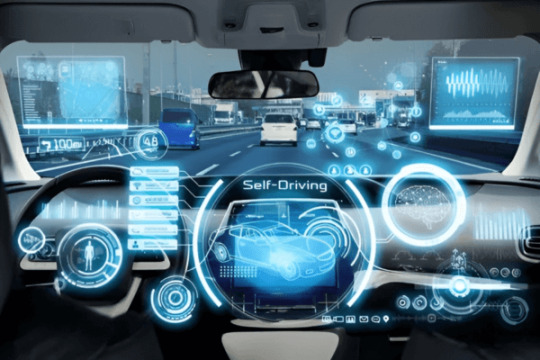
Pros of Emergency Response and AV Rescue Protocols of Autonomous Vehicles
For autonomous cars, emergency response and AV rescue techniques have a number of benefits in terms of efficiency and safety. These procedures are necessary for tackling the particular difficulties brought on by autonomous vehicles and for guaranteeing a well-organized, efficient response to emergencies. Here are some major benefits of having set AV Rescue Protocols and emergency response protocols:
Increased Safety:
Advanced safety measures in autonomous vehicles, such as collision avoidance systems, can help lessen the severity of accidents. Rescue procedures guarantee that first responders can communicate with these systems successfully, potentially averting more harm.
Quick Reaction:
Emergency responders can move quickly if AV Rescue Protocols are in place and are clear because they know how to handle a problem and where to find the information they need. In instances where there is a risk of death, this is important.
Specialized Education:
First responders need particular training as a result of AV Rescue Protocols. As a result of this training, they will be better prepared to handle AV-related situations and increase both responders’ and passengers’ safety.
Communication:

Advanced safety measures in autonomous vehicles, such as collision avoidance systems, can help lessen the severity of accidents. Rescue procedures guarantee that first responders can communicate with these systems successfully, potentially averting more harm.
Speedy passenger rescue:
Guidelines are provided by AV Rescue Protocols techniques for removing people from driverless cars securely. In situations involving accidents or medical emergencies, responders can promptly take care of passenger demands.
Reduced dangers:
Responders use AV Rescue Protocols to reduce the hazards involved in turning off or disabling a vehicle’s autonomous systems. Using the right methods can lessen the possibility that the rescue operation would unintentionally result in further damage.
Collaboration with Manufacturers:
Protocols promote communication between AV makers and emergency responders. This collaboration enables a deeper comprehension of the technology and any system flaws, enabling more efficient solutions.
Cons of AV Rescue and Emergency Response Protocols for Autonomous Vehicles
Although emergency response and AV Rescue protocol methods for autonomous cars have many benefits, they also have several drawbacks and difficulties. To ensure that protocols can be regularly developed to handle future concerns, it is crucial to take these limitations into account. The following are some drawbacks and difficulties with AV rescue and emergency response protocols for autonomous vehicles:
Complexity:
Due to the rapidly changing nature of the technology, developing and implementing standards for autonomous vehicles can be challenging. It can be difficult to make sure that responders comprehend and acclimate to the complex systems of AVs.
Cost and Resource Requirements:
It can be costly to provide emergency personnel with specialized training and to set up the necessary infrastructure to conduct AV Rescue Protocols. Budgetary restrictions may be an issue for smaller emergency response agencies.
Different vehicle capabilities:
Responders find it difficult to assess the potential and constraints of any autonomous vehicle they come across because there are various levels of automation in use. This variability must be addressed by protocols.
Lack of Standardization:
In all areas and jurisdictions, there is a dearth of established practices and norms. The absence of consistency can make emergency response operations confusing and ineffective.
Data Privacy Concerns:
Privacy issues arise when handling and gaining access to data from autonomous vehicles (AVs), which may be storing sensitive passenger data. The requirement for data in accident investigations and privacy rights must be carefully balanced.
Liability Concerns

Rapid Technological Evolution:
Since AV technology develops swiftly, AV Rescue Protocols can easily become antiquated. For regulatory organizations and first responders, it might be logistically difficult to keep protocols current with the most recent developments.
Coordination Across Stakeholders:
Coordination between multiple stakeholders, such as government agencies, law enforcement, manufacturers, and insurance companies, is frequently necessary for an effective disaster response. Collaboration might be difficult to ensure.
Conclusion:
In conclusion, emergency response and AV rescue protocols for autonomous vehicles represent an essential component of ensuring the safe and effective integration of self-driving cars into our transportation systems. While these protocols offer significant advantages in terms of safety, efficiency, and public trust, they also come with various challenges and disadvantages.
The rapid evolution of autonomous vehicle technology, the need for specialized training, data privacy concerns, and issues related to standardization and coordination among stakeholders are among the notable challenges that must be addressed.
However, the benefits of well-established protocols, such as enhanced safety, quick response, efficient passenger rescue, and clear communication, far outweigh the drawbacks. With the continued development of these protocols, the collaboration of emergency responders, AV manufacturers, and regulatory bodies, and a commitment to staying current with technological advancements, it is possible to overcome these challenges.
In the ever-changing landscape of autonomous vehicles, emergency response and AV rescue protocols play a pivotal role in ensuring that the technology serves society safely and responsibly. These protocols will continue to evolve and adapt to meet the unique needs of autonomous vehicles, promoting safety, trust, and efficiency in the era of self-driving cars.
#AutonomousRacing#EmergencyResponse#selfdrivingcars#KeylessEntry#HybridVehicle#StartSystems#dorleco#controlsystem#ADAS#eMobilityControls#AVRescueProtocols#automotive#controlunit
0 notes
Text
Autonomous Racing and Competition
October 20, 2023
by dorleco
with no comment
Autonomous Vehicle Technology
Edit

Introduction
The combination of robotics, artificial intelligence, and motorsports is an interesting and quickly developing field known as autonomous racing and competition. These competitions feature autonomous or self-driving cars racing against one another in a difficult and intense setting. An introduction to autonomous racing and competition is provided below:
1. What is autonomous racing, to start?
In autonomous racing, machines that are usually modified versions of traditional race cars compete on a track or course without human drivers. These vehicles navigate the racetrack, make judgments in real-time, and maximize their performance using a combination of sensors, cameras, lidar, radar, and advanced AI algorithms.
2. Objectives of Autonomous Racing:
The main goals of autonomous racing contests include the following:
Push the Limits of Technology: These occasions promote the development of AI, robotics, computer vision, and autonomous vehicle control systems.
They provide a forum for presenting cutting-edge products and ideas that can someday be used in practical situations, such as self-driving cars.
Autonomous racing offers a secure and regulated setting for testing and improving autonomous vehicle systems.
3. Types of Autonomous Racing Competitions:
Different formats and types of autonomous racing contests exist, including the following:
Open Track Racing: In these competitions, automobiles race on unpaved tracks while negotiating difficult twists and obstructions.
Urban Challenges: In these competitions, vehicles must maneuver through congested metropolitan areas including pedestrians, traffic, and junctions.
Off-Road Racing: Some competitions are held in off-road settings, including deserts, woodlands, or rocky terrains, where vehicles must navigate challenging terrain and unforeseen hazards.

4. Key Challenges:
Autonomous racing is not without difficulty. Among the main challenges are:
Real-time Decision-Making: In order to maximize racing speed while avoiding crashes, vehicles must make split-second decisions.
Sensor Integration: It’s essential to integrate and calibrate a variety of sensors in order to give the car precise data for navigation and control.
Mapping and Localization: Accurate mapping and localization are necessary for a vehicle to understand its location on the track.
Safety and Robustness: Protecting participants and spectators is of utmost importance, hence autonomous cars must be built with reliable safety features.
5. Prominent Autonomous Racing Events:
The Roborace, DARPA Grand Challenge, and Formula Student Driverless competitions are among the notable autonomous racing contests and events.
6. Impact and Future:
Autonomous racing has far-reaching effects that extend beyond the excitement of competition. It aids in the advancement of self-driving technologies, which have the potential to revolutionize the logistics, transportation, and other sectors of the economy. Autonomous vehicles in the real world use the developments and lessons from the racing sector.
Advantages of Autonomous Racing and Competition
The world of motorsports as well as many other businesses can benefit from autonomous competitions and racing. The following are some of the main benefits of autonomous competition and racing:
Technological Developments: Teams are challenged by autonomous racing to push the limits of robotics, artificial intelligence, and autonomous vehicle technology. Innovative technology, such as self-driving cars, delivery drones, and industrial automation, are created as a result of this innovation-driven culture.
Accelerated Development of Self-Driving Systems: Self-driving systems are being developed more quickly thanks to autonomous racing, which acts as a testing ground. It accelerates the development of autonomous vehicle technology by giving developers a controlled, high-stakes environment to hone algorithms, sensors, and control systems.
Improved Safety: The development of autonomous racing technology has improved the safety of self-driving cars on public roads in general. The knowledge gained from racing activities aids in the creation of more durable and dependable autonomous systems that can safely navigate complicated, dynamic situations.
Cost-effective Testing: Autonomous vehicle systems can be tested inexpensively during racing events. Teams can evaluate their solutions on closed tracks or courses rather than spending money on costly real-world testing on public roads, lowering the risk involved with early-stage research.

Showcasing Innovation: Autonomous racing contests give businesses and research organizations a stage on which to present their technology breakthroughs to a large audience. For additional development and commercialization, this exposure may bring about chances for funding, alliances, and collaboration.
Cross-Industry Synergy: Technologies created for autonomous racing are frequently applicable across industries. The application of lessons from racing to industries like agriculture, construction, logistics, and public transit will result in autonomous systems that are more effective and capable.
Entertainment and Fan Engagement: Autonomous racing events offer an engaging spectator experience for entertainment. They draw spectators who are passionate about both racing and cutting-edge technology thanks to their innovative combination of technology and motorsports. This may result in a greater appreciation for and interest in STEM (Science, Technology, Engineering, and Math) subjects.
Education and Skill Development: Competitions for autonomous racing provide educational opportunities for students and budding engineers. The next generation of talent in these sectors is fostered as participants receive practical experience in engineering, robotics, and artificial intelligence.
Disadvantages of Autonomous Racing and Competition
Although autonomous racing and competition have many benefits, there are certain drawbacks and difficulties in this new field. The following are some salient drawbacks:
High Costs: Participating in and developing autonomous racing contests can be very expensive. Teams spend a lot of money creating, maintaining, and improving autonomous cars. This financial barrier might only allow well-funded institutions and groups to participate.
Safety Issues: Autonomous racing involves high-speed vehicles functioning on their own, which by its very nature raises safety issues, particularly in the event of system malfunctions or unexpected conduct. The protection of participants, spectators, and event staff comes first.
Limited Real-World Applicability: While autonomous racing technology may have some real-world uses, the racing environment is frequently very different from everyday driving situations. It’s possible that the techniques and approaches refined for racing don’t always translate well to practical self-driving applications.
Narrow Focus on Speed: Speed and performance are often given top priority in racing contests, which could put other important factors like safety, dependability, and energy efficiency in the background. This may lead to an unbalanced emphasis on some features of autonomous technology.
Lack of Diverse Participation: In autonomous racing events, big businesses, academic institutions, or well-funded research organizations frequently dominate. This may restrict the variety of viewpoints and inventions and may prevent smaller and less established organizations from making contributions to the subject.
Intellectual Property Concerns: Autonomous racing contests incentivize teams to create proprietary technologies, raising concerns about intellectual property. This might result in legal battles and a reluctance to disseminate important discoveries or breakthroughs with the larger community, impeding growth as a whole.
Limited Public Awareness: Although autonomous racing might be thrilling, it could not have as wide a following or as much public awareness as traditional motorsports. It might be difficult to draw in sponsors and supporters with very little recognition.

Environmental Impact: Although energy efficiency in autonomous racing has the potential to increase, the pursuit of high speeds might result in large energy consumption, which may not be in line with sustainability and environmental goals.
Conclusion:
In conclusion, autonomous racing and competition represent a captivating fusion of cutting-edge technology, high-speed competition, and the pursuit of innovation. While the field offers numerous advantages, including technological advancements, safety improvements, and educational opportunities, it also faces challenges and drawbacks.
The advantages of autonomous racing are evident in its ability to serve as a testing ground for self-driving systems, fostering rapid development and pushing the boundaries of artificial intelligence and robotics. The competitive atmosphere encourages teams to continually improve their technologies, leading to innovations with potential applications across various industries. The educational aspect, providing hands-on experience for students and engineers, contributes to the cultivation of talent in science and technology.
However, challenges such as high costs, safety concerns, and a potentially narrow focus on speed pose significant hurdles. Safety remains a critical consideration, as the high-speed nature of racing and the unpredictability of competitive environments demand robust and reliable autonomous systems. The financial investments required may limit participation and contribute to a lack of diversity among competitors.
Additionally, while the skills developed in autonomous racing are valuable, there is a need to ensure that the technology developed is applicable and transferable to real-world scenarios. Intellectual property concerns and the potential impact on employment are also considerations that require attention.
Despite these challenges, the field of autonomous racing continues to evolve, with ongoing efforts to address safety issues, enhance real-world applicability, and foster inclusivity. As technology progresses, the lessons learned from racing events have the potential to reshape the landscape of transportation, logistics, and robotics, contributing to a future where autonomous systems play a significant role in our daily lives.
In essence, autonomous racing and competition serve as both a proving ground for technological innovation and a showcase for the capabilities of autonomous systems. Balancing the excitement of high-speed competition with the need for safety, accessibility, and real-world relevance will be crucial in determining the long-term impact and sustainability of this dynamic and evolving field.
#AutonomousRacing#Competition#selfdrivingcars#KeylessEntry#HybridVehicle#StartSystems#dorleco#controlsystem#ADAS#eMobilityControls#stroke#automotive#controlunit
0 notes
Text
Machine Learning for Autonomous Vehicles
October 19, 2023
by dorleco
with no comment
Autonomous Vehicle Technology
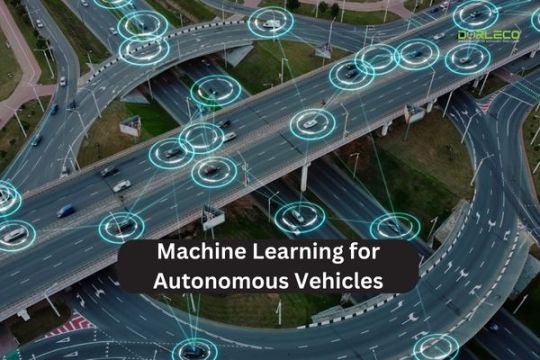
Introduction
Machine learning has greatly aided in developing and operating autonomous vehicles (AVs). Autonomous vehicles, also known as self-driving cars, can navigate and make decisions about how to drive on their own thanks to sensors, cameras, radar, and other equipment. The massive amount of data generated by these sensors is processed by machine learning algorithms to guarantee that the automobile is driven safely and effectively. This article provides a summary of machine learning’s use in autonomous vehicles.
1. Data gathering and sensors
Various sensors, including LiDAR, radar, cameras, and ultrasonic sensors, are included in autonomous cars.
These sensors gather information about the environment around the car, including the state of the roads, the presence of other vehicles, pedestrians, and traffic lights.
2. Data Preparation
Redundancy and noise are frequently present in raw sensor data. The data is cleaned and pre-processed using machine learning algorithms.
This could entail operations like data filtering, data alignment, and sensor fusion to merge data from several sensors.
3. Observation
For activities requiring perception, machine learning models are utilized to comprehend the surroundings of the vehicle.
Algorithms for object detection and recognition locate and categorize nearby items like other cars, people, and traffic signs.
Semantic segmentation classifies each pixel in an image or point cloud to help understand the road scene.
4. Regionalization
Orientation and position must be precisely determined by autonomous vehicles.
Utilizing methods like SLAM (Simultaneous Localization and Mapping), machine learning can aid in localization when combined with sensor data.
5. Planning and managing the path
The path and motion of the vehicle are planned using machine learning.
Algorithms for path planning assist the vehicle in deciding where to go and how to get there while avoiding hazards and obeying traffic regulations.
Control algorithms guarantee that the vehicle follows the intended path effectively and safely.
6. Reinforcement Learning:
For autonomous vehicles to learn from their interactions with the environment, reinforcement learning can be used.

7. Human-AI Interaction:
In autonomous vehicles, machine learning models can also be utilized to communicate with humans by comprehending their requests and explaining AI choices.
8. Data annotation and labeling:
For the purpose of training ML models in autonomous vehicles, high-quality labeled data is crucial.
The process of human annotators marking specific objects and events in sensor data is known to be labor-intensive and time-consuming.
Advantages of Machine Learning for Autonomous Vehicles
Autonomous vehicles (AVs) can benefit greatly from machine learning, which increases their capabilities, productivity, and safety. Some of the main benefits of applying machine learning to autonomous vehicles are as follows:
Enhanced Object Detection and Perception:
Large volumes of sensor data may be processed by ML algorithms, improving the detection and identification of items like pedestrians, cars, and barriers by AVs.
These algorithms improve the vehicle’s ability to perceive by adjusting to different lighting and weather situations.
Making decisions instantly:
Using historical data and their sense of the environment, AVs are able to make decisions in real-time.
When unexpected things happen, such as sudden stops or the sudden presence of pedestrians, they can respond fast.
Increased Safety:
Machine learning systems in autonomous vehicles allow them to anticipate potential dangers and take preventative action to avoid collisions.
Additionally, they can keep an eye on their surroundings constantly, lowering the possibility of driver inattention and fatigue.
Planning a path efficiently:
Algorithms for path planning based on machine learning can optimize routes to increase fuel efficiency, cut down on travel time, and lessen wear and tear on the vehicle.
AVs have the ability to dynamically change their routes based on the current flow of traffic.
Adaptive Learning:
AVs can adapt to their driving environments and learn from them thanks to machine learning. Based on facts from the real world, they may continuously enhance their performance and decision-making.
Reduced Human Error:
Human errors, which are a major factor in traffic accidents, such as distracted driving, fatigue, or poor judgment, are not common in autonomous vehicles.
Traffic Management:
By coordinating AVs and enhancing general traffic management, machine learning can be utilized to improve traffic flow.
To ease congestion, AVs can communicate with one other and the traffic infrastructure.
Reduced Fuel Consumption and Emissions:
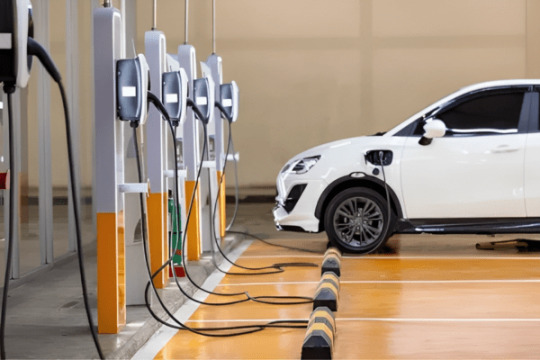
Disadvantages of Machine Learning for Autonomous Vehicles:
While machine learning has many benefits for autonomous vehicles (AVs), there are also a number of serious drawbacks and difficulties that come with its application in this setting:
Safety Concerns:
ML models are unreliable and susceptible to errors, raising questions about AV safety. A machine learning algorithm’s poor choice could have fatal repercussions.
Lack of Common Sense:
Lacking common sense reasoning, ML models may find it difficult to comprehend complicated, unstructured circumstances when driving.
Data Quality and Diversity:
High-quality and varied training data are essential to machine learning models. It might be difficult to ensure that data adequately depicts all conceivable circumstances, including uncommon and edge cases.
Data Annotation Costs:
Given the enormous amount of data needed for AV development, labeling and annotating training data for ML models can be expensive and time-consuming.
Data Privacy Concerns:
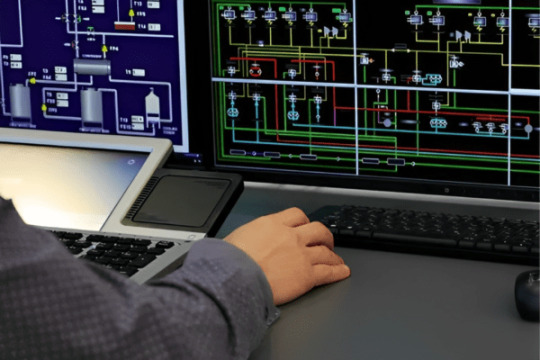
Adversarial Attacks:
Adversarial attacks, in which hostile actors try to trick or manipulate the algorithms by giving false sensor data, can affect machine learning models in AVs.
Limited Robustness:
ML models may not generalize well, and as a result, they may not perform well in unexpected or uncommon circumstances that differ from their training data.
Regulatory Challenges:
Machine learning-based AV development and deployment require navigating complicated regulatory environments, some of which may not yet be fully responsive to this cutting-edge technology.
Conclusion:
In conclusion, ML is a transformative technology that plays a central role in the development and operation of autonomous vehicles (AVs). Its integration brings a multitude of benefits and challenges to the world of transportation.
As the industry continues to evolve, it is essential to address these challenges and harness the advantages of ML in autonomous vehicles responsibly. Collaboration between industry stakeholders, regulators, researchers, and the public is crucial to ensure that AVs become a safe, efficient, and accessible mode of transportation that benefits society as a whole. While there are hurdles to overcome, the potential for ML in autonomous vehicles remains promising, with the prospect of revolutionizing the way we travel and enhancing road safety.
#AutonomousAerialVehicles#Drones#AAVs#KeylessEntry#HybridVehicle#StartSystems#dorleco#controlsystem#ADAS#eMobilityControls#stroke#automotive#controlunit#PowertrainControl#ConnectedAutonomousVehicles
0 notes
Text
Autonomous Aerial Vehicles (Drones)
October 17, 2023
by dorleco
with no comment
Autonomous Vehicle Technology
Edit

Introduction
Drones, or autonomous aerial vehicles (AAVs), have grown in popularity in recent years due to their adaptability and variety of uses. The military usage of these unmanned aircraft has given way to a number of civilian and business uses. The main features of AAVs, including their types, components, uses, and some of the difficulties they offer, will be covered in this introduction.
1. Different AAV types
Autonomous Aerial Vehicles come in a variety of forms, each created for particular purposes and settings. The most typical categories are:
Multirotor Drones: These drones, which often have four or more rotors, are distinguished by their stability, agility, and controllability. They are frequently employed for short-distance deliveries, surveillance, and aerial photography.
Fixed-Wing Drones: These drones have fixed wings and propellers, making them resemble conventional airplanes. They are frequently employed for jobs like mapping, agriculture, and aerial surveying since they are more effective for traveling large distances.
Hybrid Drones: Providing flexibility for varied applications, hybrid drones integrate aspects of both multirotor and fixed-wing designs. They can fly forward efficiently like fixed-wing aircraft and can take off and land vertically like multi-rotors.
Single-rotor and coaxial helicopters: Though less prevalent, these drones excel at a variety of specialized jobs, including heavy lifting and aerial filming.
2. Important Elements:
Autonomous Aerial Vehicles are made up of several crucial parts:
Propulsion System: The drone’s propulsion system consists of the motors, rotors, or engines that give it lift and forward motion.
Flight Controller: An onboard computer that regulates the speed of each motor or rotor to steady and control the drone’s flight.
GPS receiver: Offers location information and aids in self-driven navigation.
Sensors: To ensure stable flying and collision avoidance, drones are outfitted with a variety of sensors, including gyroscopes, accelerometers, barometers, and obstacle avoidance sensors.
Communication System: Drones frequently interact with ground stations or other drones to coordinate missions and are controlled remotely via radio signals.
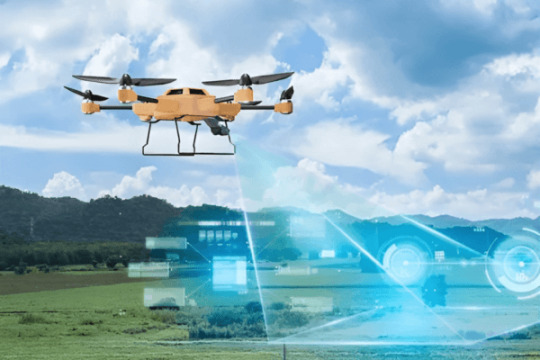
Power Source: Rechargeable lithium-polymer or lithium-ion batteries are used to power the majority of drones.
3. Applications
Autonomous Aerial Vehicles have numerous uses in a variety of sectors, including:
Photography and Videography: Aerial photography and cinematography for movies, real estate, and events are examples of photography and videography.
Agriculture: Precision farming, pesticide application, and crop monitoring.
Search and Rescue: Supporting efforts to find missing people and provide disaster aid.
Infrastructure Inspection: Inspection of the infrastructure, including pipelines, bridges, and electricity lines.
Environmental monitoring: keeping an eye on deforestation, climate change, and wildlife.
Package Delivery: Businesses like UPS and Amazon are looking into drone delivery options.
Security and surveillance: Keeping an eye on vast areas for security reasons.
Mapping and Surveying: Producing detailed 3D maps and measuring land.
4. Difficulties
Autonomous Aerial Vehicles are faced with a number of difficulties as they develop:
Regulation: Different regions have different laws and rules, which can make drone operations challenging.
Safety: Collisions, problems, and loss of control can result in mishaps that put persons and property in danger.
Privacy Issues: The possibility of intrusive surveillance is a major issue.
Airspace Management: To prevent collisions, drone flight paths must be coordinated with those of other aircraft.
Battery Life: For the majority of drones, a short battery life limits flight time and range.
Impact on the environment: Particularly in urban areas, noise pollution, and environmental concerns might be problems.
Benefits of Autonomous Aerial Vehicles (Drones)
Drones, or autonomous aerial vehicles (AAVs), provide numerous advantages in a variety of fields and applications. The following are some of the main benefits of Autonomous Aerial Vehicles:
Cost-Effective: AAVs may frequently complete jobs more affordably than conventional techniques. Drones, for instance, may more precisely administer pesticides and monitor crops in agriculture, minimizing the need for expensive machinery and physical labor.
Time Efficiency: AAVs are capable of doing jobs swiftly and effectively. For example, they can undertake aerial photography, evaluate infrastructure, or survey enormous amounts of land in a fraction of the time it would take using conventional techniques.
Safety: By using AAVs in dangerous or hard-to-reach places, the risk to human employees is reduced. For instance, they can carry out perilous search and rescue missions, and inspect electricity lines, and pipelines.
Environmental Benefits: When compared to conventional aircraft or ground vehicles, drones have a lesser environmental impact. They are more environmentally friendly because they frequently use electric power sources, produce fewer pollutants, and have lower noise levels.
Precision and Accuracy: In industries like agriculture, where precise crop spraying and monitoring can improve yields and save waste, AAVs’ high precision and accuracy in task execution are essential.
Remote sensing and surveillance: Drones can continuously observe a region, improving security and monitoring capabilities. They are employed in disaster management, animal monitoring, and border security.

Flexibility and Adaptability: AAVs are adaptable to a wide range of applications since they may be fitted with a variety of sensors and payloads. They don’t require major changes to be configured for various jobs.
Aid in Emergencies: Drones can be quickly deployed in disaster-affected areas to survey damage, find survivors, and provide supplies that are necessary in an emergency. They are essential resources for search and rescue operations.
Drawbacks of Autonomous Aerial Vehicles (Drones)
Drones, or autonomous aerial vehicles (AAVs), have many advantages but also a number of disadvantages and difficulties. To use drones effectively, it’s imperative to be aware of these restrictions. The following are some AAV drawbacks:
Regulatory Obstacles: AAVs must adhere to stringent rules in several nations. These rules encompass things like required licenses, no-fly zones, and flight height. It might be difficult to follow these regulations, particularly for industrial and recreational users.
Safety Issues: Drones can provide dangers to safety both on the ground and in the air. Inexperienced pilots run the risk of endangering both persons and property when they unintentionally cause accidents, such as collisions with other planes or buildings.
Privacy Concerns: Drones with cameras and other sensors pose the risk of invading people’s personal space. Significant issues include the gathering of personal data and unauthorized surveillance. It can be difficult to strike a compromise between drones’ advantages and people’s right to privacy.
Limited Payload Capacity: The majority of consumer-grade drones have a payload capacity that limits their ability to do specific jobs, such as carrying large scientific instruments or heavy cargo.
Short Battery Life: Drones have a short battery life, which for consumer versions typically falls between 20 and 40 minutes. This limits their operating range and duration and necessitates frequent charging.
Weather Sensitivity: A drone’s capacity to fly safely and effectively might be restricted by unfavorable weather conditions, such as high winds, heavy rain, and extreme temperatures.
Maintenance and Repairs: Regular maintenance is necessary for drones, and any faults may call for pricey repairs. Downtime and increased expenses may result from this.
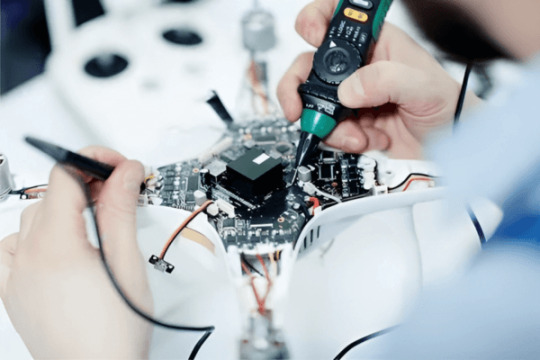
Complex Operation: Despite the fact that current drones are easier to handle, they still need a certain amount of expertise to operate efficiently. For novices, learning how to fly and operate a drone might be difficult.
Conclusion:
In conclusion, Autonomous Aerial Vehicles (AAVs), more commonly known as drones, have emerged as versatile tools with a wide range of applications and the potential to bring transformative changes to various industries. The benefits of AAVs, including cost-effectiveness, time efficiency, safety, and environmental advantages, are evident and compelling. These devices have the power to revolutionize fields such as agriculture, infrastructure inspection, surveillance, and emergency response, among others.
However, Autonomous Aerial Vehicles are not without their drawbacks and challenges. Regulatory complexities, safety concerns, privacy issues, and operational limitations are factors that demand careful consideration and responsible usage.
The future of AAVs hinges on a harmonious balance between realizing their full potential and addressing these challenges. As technology advances and regulations evolve, drones will continue to play an increasingly significant role in our lives. To harness the full spectrum of benefits AAVs offer, it is crucial to emphasize education, ethical practices, and responsible governance. With the right approach, drones can indeed be transformative tools, enhancing efficiency, safety, and our ability to explore and interact with the world from a new perspective.
#AutonomousAerialVehicles#Drones#AAVs#KeylessEntry#HybridVehicle#StartSystems#dorleco#controlsystem#ADAS#eMobilityControls#stroke#automotive#controlunit#PowertrainControl#ConnectedAutonomousVehicles
0 notes
Text
Autonomous Vehicle Hardware
October 16, 2023
by dorleco
with no comment
Autonomous Vehicle Technology
Edit
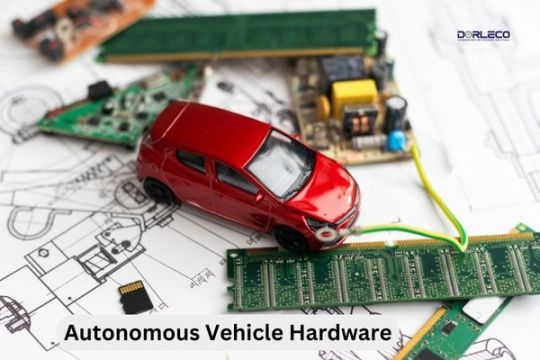
Introduction
Self-driving cars, also known as autonomous vehicles, are a cutting-edge technology that has the potential to revolutionize transportation while also making our roadways safer and more effective. For autonomous operation and navigation, these vehicles rely on a combination of hardware and software components. In this introduction, we’ll concentrate on the Autonomous Vehicle Hardware elements that are essential to autonomous vehicles’ proper operation.
1. Sensors:
A variety of sensors are installed in autonomous cars to give them information about their surroundings. These sensors consist of:
LiDAR (Light Detection and Ranging): LiDAR sensors produce thorough 3D maps of the surroundings of the vehicle using laser pulses. The location and movement of adjacent objects, pedestrians, and other cars are better understood by the vehicle thanks to these maps.
Radar: Radio waves are used by radar devices to measure an object’s speed and distance. Because they are less impacted by rain, fog, or snow than LiDAR is, they are especially helpful in bad weather.
Cameras: High-resolution cameras record the environment on film and in still photos. These photos are processed by sophisticated computer vision algorithms in order to distinguish pedestrians, read road signs, and identify objects.
Ultrasonic Sensors: Ultrasonic sensors use sound waves to go from the vehicle to adjacent objects, and then they time how long it takes for the sound to return.
GPS: For localization and navigation, use the Global Positioning System (GPS). It aids accurate navigation by giving the car information about its precise location.
2. Computing Hardware:
Central Processing Unit (CPU): Autonomous Vehicle Hardware comes with potent CPUs that can process massive volumes of data in real-time. The software that analyzes sensor data and decides how to maneuver the car is run by these CPUs.
Graphics Processing Unit (GPU): GPUs are used to speed up the processing of visual activities like image recognition and computer vision that need sophisticated visual input.
FPGA (Field-Programmable Gate Array): Field-Programmable Gate Arrays, or FPGAs, are hardware elements that may be reprogrammed to perform particular functions. They are utilized for signal processing and real-time control.
Sensor Fusion Units: These units fuse data from numerous sensors to build a full picture of the world around the vehicle. Making safe driving judgments depends on this.

3. Control Systems:
Actuators are in charge of regulating the vehicle’s movement, including steering, braking, and acceleration. They are necessary for carrying out the decisions made by the software of the autonomous vehicle.
Drive-By-Wire Systems: Drive-by-wire systems, which switch out conventional mechanical connections for electronic controls, are a common feature of autonomous vehicles. As a result, the control system and the vehicle’s components are able to communicate and be controlled precisely.
4. Systems for Communications:
Vehicle-to-Everything (V2X) communication allows for vehicle-to-vehicle communication as well as communication with other cars and infrastructure like traffic signals and road signage. The exchange of information can improve traffic flow and safety.
5. Systems for redundancy and safety
To protect safety, autonomous cars frequently have redundancy and backup systems. This includes extra sensors, backup power systems, and fail-safe devices.
6. HMI: Human-Machine Interface
The HMI serves as the interface for users and passengers to communicate with the car. It has user-friendly features including displays, speech recognition, and others.
Benefits of Autonomous Vehicle Hardware
Autonomous vehicle hardware has a number of advantages in terms of efficiency and safety, which is what is causing this ground-breaking technology to be developed and adopted. The following are a few of the major advantages of autonomous vehicle hardware:
1. Increased Safety:
Reduced Human Error: The major causes of accidents such as driver weariness, distraction, and faulty judgment are not common in Autonomous Vehicle Hardware. Hardware elements like sensors and cameras let vehicles make judgments more quickly and accurately, lowering the chance of accidents.
Advanced Sensor Technology: LiDAR, radar, and video systems with advanced sensor technology offer a 360-degree view of the area around the vehicle, seeing obstacles and potential risks instantly. The improved perception and attentiveness make driving safer.
Better Reaction Time: Compared to human drivers, autonomous vehicles can react to problems considerably more quickly. They have the ability to process data in milliseconds and swiftly and precisely carry out directives like braking or steering.
Predictive Analysis: Machine learning algorithms, which are a component of the hardware and software stack, may examine previous data and forecast potential mishaps or hazards, enabling the vehicle to take preventative action to avoid them.
2. Reduced Traffic Congestion:
Effective traffic flow is possible thanks to autonomous cars’ ability to communicate with one another and with traffic infrastructure. This connectedness may result in less congestion, smoother traffic flow, and more overall transportation effectiveness.
GPS and traffic information can be used to choose the fastest routes in real time, avoiding gridlock and congestion.
3. Reduced fuel use and emissions:
Driving Pattern Optimization: To cut down on fuel use and pollution, autonomous cars can make the best use of their acceleration and deceleration strategies.
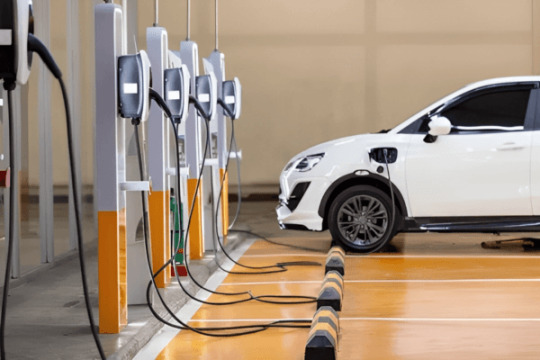
4. Accessibility:
Enhanced Mobility: Using Autonomous Vehicle Hardware can provide accessibility and freedom for people who are unable to drive due to age, disability, or other reasons.
Transportation on Demand: Ride-sharing and autonomous taxi services can provide comfortable transportation on demand to a wider spectrum of consumers.
5. Reduced Fatalities and Traffic Accidents:
The number of traffic accidents and consequent fatalities can be greatly decreased by doing away with human error and implementing cutting-edge safety measures.
6. Efficiency of Parking
Passengers can be dropped off at their destination by Autonomous Vehicle Hardware, which can then locate parking on their own. This may result in less urban congestion and more effective utilization of parking spaces.
7. Transportation as a Service:
With the introduction of autonomous vehicle fleets run by ride-sharing or transportation service providers, fewer people could need to buy their own cars, which might reduce traffic and save people money.
8. Improved Traffic Management:
In order to improve the administration of traffic signals and congestion, autonomous vehicles can contribute useful data to traffic management systems.
Drawbacks of Autonomous Vehicle Hardware
Autonomous Vehicle Hardware has many benefits, but there are also several serious disadvantages and difficulties with the technology. For autonomous vehicles to be widely used, these drawbacks and issues must be resolved. Here are a few negatives:
1. Cost:
Autonomous Vehicle Hardware, such as cutting-edge sensors, potent CPUs, and redundant systems, can be pricey. Both consumers and producers may find this price to be a substantial barrier to entry.
2. Complexity:
Autonomous Vehicle Hardware and software are quite complicated. These systems can be difficult to maintain, debug, and repair, and they can be expensive.
3. Reliability:
Although safety and redundancy are considered when designing autonomous vehicle technology, system failures or malfunctions are still a possibility. A crucial priority is ensuring the dependability and safety of every piece of gear.
4. Cybersecurity:

5. Ethical Conundrums:
When faced with moral dilemmas, autonomous vehicles may have to decide between protecting their passengers or pedestrians in an accident. Discussions about how to handle these moral conundrums are ongoing.
6. Replaced Employment:
The widespread use of autonomous cars in sectors like logistics and transportation could result in employment losses. Professional drivers, such as taxi and truck drivers, may encounter difficult employment situations.
7. Infrastructure Acceptance:
It’s possible that the current road system isn’t fully prepared to support autonomous vehicles. It could be expensive and time-consuming to upgrade the infrastructure to enable V2X connectivity and other functionalities.
8. Concerns about data privacy:

Conclusion:
In conclusion, the Autonomous Vehicle Hardware is a critical component of the emerging technology that promises to reshape transportation and enhance our daily lives. These vehicles are equipped with a sophisticated array of sensors, computing systems, control units, and communication devices that enable them to operate safely and efficiently without human intervention. The benefits of autonomous vehicle hardware include improved safety, reduced traffic congestion, lower fuel consumption, increased accessibility, and the potential for significant cost savings.
However, alongside these advantages, there are noteworthy challenges and drawbacks that must be addressed. These include the high cost of hardware, complexity, reliability concerns, cybersecurity risks, regulatory and legal hurdles, and the need to gain public acceptance and trust.
The development and adoption of autonomous vehicle hardware represent a transformative journey that requires collaboration between technology companies, automakers, governments, and the public. As technology continues to advance, it is essential to prioritize safety, address ethical dilemmas, and work toward an inclusive and sustainable future for autonomous vehicles. The balance between the advantages and challenges will ultimately determine the extent to which autonomous vehicles become a part of our daily lives and the extent to which they revolutionize transportation.
#KeylessEntry#HybridVehicle#StartSystems#dorleco#controlsystem#ADAS#eMobilityControls#stroke#automotive#controlunit#PowertrainControl#ConnectedAutonomousVehicles
0 notes
Text
Connected Autonomous Vehicles (CAVs)

Introduction
The term “connected autonomous vehicles” (CAVs), sometimes known as “autonomous cars” or “self-driving cars,” denotes a revolutionary advancement in both automotive and transportation systems. These cutting-edge vehicles incorporate cutting-edge technology to enable them to function without human intervention and are connected to both the internet and the larger transportation system. CAVs promise to make transportation safer, more effective, and more convenient while ushering in a new era of mobility.
Connected Autonomous Vehicles range from somewhat autonomous to fully autonomous in terms of automation. They use a variety of sensors, cameras, lidar, radar, and sophisticated algorithms to sense their environment and make judgments in real time.
These vehicles can handle congested intersections, navigate through traffic, and adapt to shifting road conditions, thereby lowering the likelihood of accidents brought on by human mistakes.
CAV connection is an equally important component. These cars have communication systems that let them share information with other CAVs, traffic control systems, and even the gadgets of pedestrians. Through interactions between vehicles and infrastructure (V2I) over this communication network, CAVs are able to exchange data about traffic, road conditions, and other topics. The foundation of improved traffic management and safety is this real-time data interchange.
CAVs could have a variety of advantages. As they can react more swiftly and predictably than human drivers, they have the potential to greatly reduce traffic accidents and fatalities. CAVs can reduce traffic congestion by streamlining traffic and giving users quicker paths. Additionally, they might improve accessibility, restoring mobility to those who are unable to drive due to age, disability, or other factors.
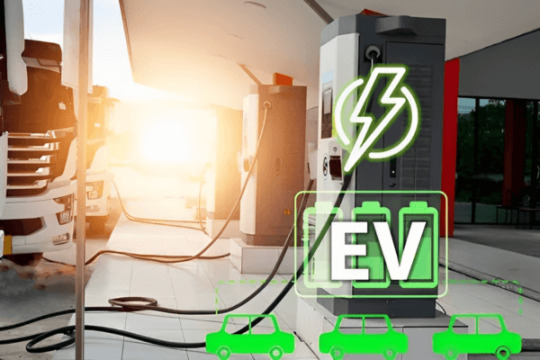
Benefits of Connected Autonomous Vehicles (CAVs)
The use of connected autonomous vehicles (CAVs) has the potential to significantly improve many facets of transportation and society at large. The following are some of the main benefits of CAVs:
Increased Safety: CAVs have the potential to significantly lower traffic fatalities and accidents. They have cutting-edge sensors and algorithms that let them recognize risks and respond to them more swiftly and predictably than human drivers. Additionally, through vehicle-to-vehicle (V2V) and vehicle-to-infrastructure (V2I) connectivity, CAVs can interact with one another and exchange real-time information, improving safety.
Reduced Congestion: CAVs can facilitate smoother traffic flow by coordinating with one another and maximizing speed and spacing. Additionally, they can pick the fastest routes, which will cut down on traffic and the amount of time spent on it. As a result, there may be a decrease in fuel use and greenhouse gas emissions.
Enhanced Accessibility: People who are unable to drive due to age, impairments, or other factors may be able to move around with the help of CAVs. They can provide greater mobility options and newfound independence to a variety of people, including the elderly and those with impairments.
Greater Fuel Efficiency: CAVs can be programmed to operate with less fuel and produce fewer emissions. They can determine the best routes, prevent idling, and smoothly accelerate and brake, all of which improve fuel efficiency.
Reduced demand for Parking: Because Connected Autonomous Vehicles can quickly locate parking places after dropping off passengers, there will be less demand for vast parking lots and garages. This can cut down on time and tension spent looking for parking and free up valuable urban space for other uses.
Economic Benefits: The creation of new jobs in the autonomous vehicle-related sectors of software development, infrastructure construction, and maintenance may result from the development and use of CAVs. Given that people can work or unwind during their commutes, it may also result in higher productivity.
Enhanced Productivity and Quality of Life: CAVs can give passengers time to work, unwind, or partake in recreational activities throughout their travels. This can improve living conditions and increase the effectiveness of transportation.
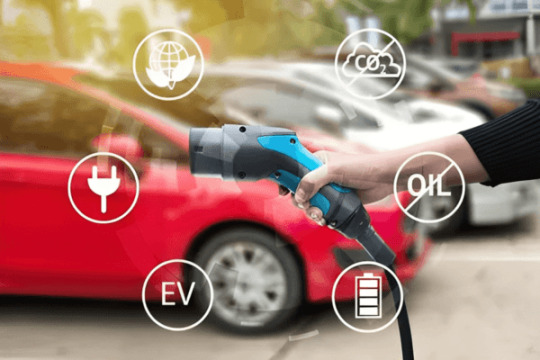
Drawbacks of Connected Autonomous Vehicles (CAVs)
While connected autonomous vehicles (CAVs) have many advantages, there are a number of disadvantages and difficulties as well. Given these constraints, it’s crucial to keep in mind how the technology is evolving and how it’s being integrated into our transportation networks. CAVs have a number of disadvantages, including:
Safety Concerns: Although CAVs may increase traffic safety, they are not impervious to technical difficulties or cyber-attacks. A crucial difficulty is ensuring the security and dependability of autonomous systems. Additionally, there may be new safety issues during the transitional phase when CAVs and human-driven vehicles coexist on the road.
High initial costs: The development and implementation of CAV technology, including the sensors, cameras, lidar, radar, and sophisticated software, can be costly. The early accessibility of CAVs may be limited by this expense, which also necessitates a substantial investment in infrastructure and fleets of vehicles.
Limited Infrastructure Adaptation: The widespread use of Connected Autonomous Vehicles may necessitate significant infrastructure changes, such as new road signs, traffic lights, and increased connectivity. Infrastructure retrofitting can be expensive and time-consuming.
Privacy Issues: In order to function effectively, CAVs collect and send a lot of data. It is necessary to address worries about data ownership, privacy, and potential exploitation by manufacturers or other organizations.
Job displacement: Since autonomous technology eliminates the need for human drivers in sectors like haulage and ride-sharing, it may result in job displacement. The financial effects of job loss and the requirement for retraining and reskilling must be taken into account.
Complex Liability and Regulatory Issues: Complex liability and regulatory issues must be addressed as CAV regulations continue to develop. It can be difficult to determine who is at fault in an accident involving an autonomous vehicle.
Technology Dependence: As society depends more on CAVs, there is a danger of becoming overly dependent on technology. This can be a problem if there are any unanticipated system outages, technical difficulties, or other disturbances.

Conclusion:
Connected Autonomous Vehicles (CAVs) represent a remarkable advancement in the field of transportation, offering the potential to revolutionize the way we move and live. These vehicles, equipped with cutting-edge technology and connectivity, have the capacity to bring numerous benefits to society, such as improved safety, reduced traffic congestion, increased accessibility, and environmental advantages. However, they also come with a set of challenges, including safety concerns, high initial costs, regulatory complexities, and ethical dilemmas, which need to be carefully addressed for the widespread adoption and acceptance of CAVs.
As Connected Autonomous Vehicles technology continues to evolve and mature, collaboration between governments, industry leaders, and research institutions is essential to address these challenges. Safety measures and robust cyber security protocols must be implemented to ensure that CAVs live up to their potential as safer alternatives to human-driven vehicles. Furthermore, the development of clear regulatory frameworks will be pivotal in providing a structured path for CAV integration while protecting the rights and privacy of individuals.
In conclusion, the era of Connected Autonomous Vehicles holds immense promise for transforming the way we experience transportation and enhancing our daily lives. While it comes with its share of complexities and hurdles, the potential benefits, from safer roads to reduced environmental impact and improved accessibility, make the journey towards CAVs an exciting and worthwhile endeavor that will shape the future of mobility and urban living.
#KeylessEntry#HybridVehicle#StartSystems#dorleco#controlsystem#ADAS#eMobilityControls#stroke#automotive#controlunit#PowertrainControl#ConnectedAutonomousVehicles
0 notes
Text
Autonomous Vehicle Perception: Enabling Self-Driving Cars

Introduction
The creation of autonomous vehicles, often known as self-driving cars, has completely changed the automotive sector and the transportation sector as a whole. These automobiles have the power to improve traffic flow, lessen congestion, and expand accessibility for those with disabilities. The vision system of autonomous vehicles is one of the key components that enables them to navigate the complicated world of roads and highways.
Self-driving automobiles function on the basis of autonomous vehicle perception. It entails the vehicle’s capacity to perceive and comprehend its environment, evaluate the data gathered by numerous sensors, and base decisions on this knowledge. The main elements and technology involved in autonomous vehicle perception will be covered in this introduction.
Sensors: To gather information about their surroundings, autonomous cars rely on a variety of sensors. LiDAR (Light Detection and Ranging), radar, cameras, ultrasonic sensors, and inertial measurement units (IMUs) are some of these sensors. Each type of sensor has a specific function; for example, LiDAR and radar are required for measuring distance and detecting objects, while cameras are required for visual identification and IMUs for tracking the motion of the vehicle.
Data Fusion: These sensors produce a variety of noisy data in various formats. This data is combined and processed using data fusion techniques to create a cohesive, coherent depiction of the environment around the vehicle. In order to build a reliable perception system, sensor fusion techniques are essential.
Object detection and tracking: For an autonomous vehicle to navigate safely, nearby objects must be identified and tracked. This entails recognizing people on foot, other cars, traffic signals, and road markers. These tasks are carried out by sophisticated computer vision algorithms, frequently utilizing deep learning methods like convolutional neural networks (CNNs) and recurrent neural networks (RNNs).

Semantic Segmentation: Autonomous vehicles must comprehend the semantics of their surroundings in order to perform semantic segmentation. The method of semantic segmentation involves assigning a category to each pixel in a picture, such as recognizing streets, walkways, and obstacles. The vehicle uses this information to decide how to change lanes, turn, and avoid obstacles.
Mapping and Localization: High-definition maps and exact localization are used by autonomous vehicles to detect their location on the road. Simultaneous Localization and Mapping (SLAM) algorithms assist the vehicle in mapping its surroundings and locating itself within those maps.
Machine Learning and AI: Artificial intelligence and machine learning: Machine learning is essential for autonomous vehicle sensing. In order to increase their capacity to recognize and comprehend complicated situations on the road, deep learning models are trained on enormous datasets. Through updates and actual driving experience, these models continuously change and get better over time.
Advantages of Autonomous Vehicle Perception: Enabling Self-Driving Cars
A variety of benefits provided by autonomous vehicle perception, which enables self-driving automobiles to sense and comprehend their environment, have the potential to revolutionize both society and transportation. The following are some major benefits of perception in autonomous vehicles:
Enhanced Safety: Enhanced safety is one of the main advantages of autonomous vehicle perception. Lidar, radar, cameras, and ultrasonic sensors, among other sophisticated sensors, continuously scan the area around the car and provide a very accurate 360-degree vision. Autonomous vehicles can anticipate and react to potential hazards thanks to their broad awareness, which lowers the chance of accidents brought on by human mistakes, such as distracted or intoxicated driving.
360-Degree Awareness: Autonomous vehicle perception systems give drivers a full picture of their surroundings, including any nearby objects and potential hazards. With this skill, self-driving cars can identify other vehicles, pedestrians, cyclists, and stationary objects, allowing them to make wise decisions and safely negotiate challenging traffic situations.
Predictive Analytics: Autonomous vehicle perception systems employ predictive analytics to foresee the actions of other road users and objects. Self-driving cars’ predictive abilities enable them to respond proactively to impending dangers, making driving safer and more predictable.
Improved Decision-Making: Perception systems use machine learning algorithms to make driving decisions after processing enormous volumes of sensor data. These choices are made based on real-time data, traffic laws, and the vehicle’s pre-programmed goals, enabling the vehicle to successfully negotiate complicated and dynamic settings.
Autonomous vehicles have the ability to adapt their driving style in response to their environment. They can, for instance, slow down in congested areas, keep safe following distances, and make split-second judgments to avert collisions, all of which help to make roads safer.
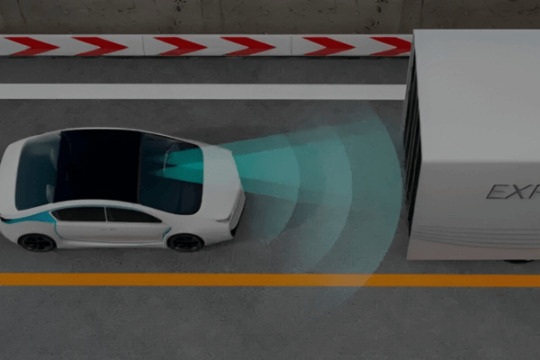
Effective Traffic Flow: Self-driving automobiles with perceptual capabilities can interact with traffic control systems and with each other. This communication may result in less traffic congestion, faster travel times, and more effective traffic flow.
Reduced Fuel Consumption and Emissions: Autonomous vehicle perception systems can tailor driving behaviors for maximum fuel economy, resulting in fewer emissions and fuel consumption. They can make it easier to operate hybrid and electric vehicles, which will lessen their influence on the environment.
Data Collection and Analysis: Autonomous cars have the ability to gather and transmit information regarding traffic patterns, road conditions, and infrastructure requirements. Urban planning, traffic control, and the general improvement of transportation systems can all benefit from this data.
Drawbacks of Autonomous Vehicle Perception: Enabling Self-Driving Cars
Although autonomous vehicle perception has many benefits, there are also a number of downsides and difficulties that must be resolved for the successful implementation of self-driving automobiles. The following are some major issues with autonomous vehicle perception:
Sensor Restrictions: To sense their environment, autonomous vehicles rely on a range of sensors, including cameras, lidar, radar, and ultrasonic sensors. Adverse weather conditions, such as persistent rain, snowfall, fog, or glare, might have an impact on these sensors and reduce their accuracy and dependability.
Cost of the sensor: Premium sensors, particularly lidar and high-resolution cameras, can be pricey. This expense may reduce the availability of self-driving technology and raise the overall cost of autonomous vehicles.
Sensor Maintenance: Regular cleaning and maintenance of sensors is necessary to maintain their correct operation. The performance of sensors can be hampered by the accumulation of dust, grit, and debris on their surfaces.
Sensor Redundancy: In autonomous cars, redundant sensors are essential for safety. Other sensors should be able to compensate if one fails. Redundancy assurance can be difficult and expensive.
Limited Perception Range: The limited range of some sensors, like as lidar, may affect a vehicle’s ability to identify objects at a distance. When traveling at high speeds or on highways, this restriction can be difficult to manage.
Legal and Ethical Problems: Determining who is responsible for accidents involving autonomous vehicles might be difficult. Setting up moral guidelines for making decisions in emergency situations is a never-ending challenge.
Human Interaction: Autonomous cars must successfully express their intent and awareness to human drivers, pedestrians, and cyclists in order to interact with them. It can be difficult to ensure smooth communication between autonomous and human-driven cars.

Vulnerability to Sensor Spoofing: Autonomous vehicles are susceptible to attacks called sensor spoofing, in which criminals modify sensor data to trick the vehicle’s perception system.
Conclusion:
In conclusion, autonomous vehicle perception is a ground-breaking technology that forms the cornerstone of self-driving cars, offering tremendous potential benefits while also presenting significant challenges. The advantages of autonomous vehicle perception include improved safety, reduced traffic congestion, enhanced accessibility, lower operating costs, and environmental benefits. Moreover, this technology has the potential to transform transportation systems and make mobility more efficient and convenient.
However, the adoption of autonomous vehicle perception is not without its drawbacks and hurdles. These include the cost of technology, limitations in adverse weather conditions, technical challenges, ethical dilemmas, data privacy and security concerns, job displacement, legal and liability issues, vulnerability to cyberattacks, and resistance to change among the public.
To unlock the full potential of autonomous vehicle perception and overcome these challenges, it is essential for stakeholders, including governments, industries, and researchers, to collaborate closely. Investments in research and development, rigorous testing and validation processes, the establishment of clear regulations and standards, and public education are all critical components of a successful transition to autonomous transportation.
While there are still many obstacles to address, the continued advancement of autonomous vehicle perception technology holds the promise of safer, more efficient, and more accessible transportation systems in the future. As these systems evolve, they have the potential to reshape the way we move and interact with our cities and roads, ultimately offering a brighter and more sustainable future for transportation.
#KeylessEntry#HybridVehicle#StartSystems#dorleco#controlsystem#ADAS#eMobilityControls#stroke#automotive#controlunit#PowertrainControl#AutonomousVehiclePerception
0 notes
Text
Keyless Entry and Start Systems: BCM’s Contribution to Security

Introduction
Modern vehicles increasingly use keyless entry and start systems because they provide convenience and better security features. For secure and keyless access to a car, these systems rely on a variety of technologies, including key fobs, sensors, and the Body Control Module (BCM). In this introduction, we’ll look at the fundamentals of keyless entry and start systems with a focus on the BCM’s contribution to security.
1. Overview of Keyless Entry and Start Systems
Keyless entry and start mechanisms, often known as “smart keys” or “proximity keys,” have completely changed how we enter and start our cars. These systems enable drivers to start, unlock, and secure their cars without removing the key fob from their pocket or bag. This replaces the need for a conventional physical key.
2. Important Elements of Systems for Keyless Entry and Start
Key Fob: The key fob is a little gadget that communicates with the car by sending out a wireless signal. Typically, it has buttons for starting, locking, and unlocking the vehicle. Key fobs connect to the vehicle via radio frequency (RF) or Bluetooth technology.
Sensors: The car is fitted with a number of sensors that can identify when the key fob is nearby. The sensors detect the key fob’s existence and permit entry when it is close to the car—generally within a few feet.
Body Control Module (BCM): The body control module (BCM) is a crucial part of the electrical control system of the car. It serves as the main control point for all of the car’s electrical systems, including the keyless entry and start systems. The key fob sends signals to the BCM, which decodes them and regulates access to the car accordingly.
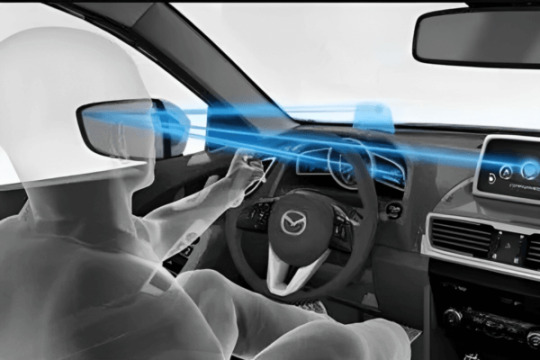
3. Keyless entry and start system operation
Access Control: The sensors recognize the key fob when it is in your pocket or backpack and alert you when you approach your car. Once access has been authorized by the BCM, you can unlock the car by merely touching the door handle or pressing a button.
Push-Button Start: Once inside the car, you can start the engine by pushing a button that is usually marked “Engine Start” or something similar. Before allowing the engine to start, the BCM confirms the validity of the key fob.
4. BCM’s Security Contribution
Encryption: By ensuring that the connection between the key fob and the car is encrypted, the BCM plays a critical role in strengthening security. This encryption makes it very difficult for hackers to intercept or duplicate the signals, preventing unwanted access and stealing attempts.
Anti-Theft Measures: The BCM may have anti-theft capabilities in addition to encryption. To further protect the car from theft, it can, for instance, deactivate the engine start function if it discovers an unauthorized or duplicate key fob.
Monitoring and Alerting: Some sophisticated BCMs can keep an eye out for unusual activities in the keyless entry and start system. It has the ability to set off alerts, alert the owner, or even temporarily disable some features in the event that it notices any strange activity or attempts at illegal access.
Benefits of Keyless Entry and Start Systems: The Security Contribution of BCM
Systems for keyless entry and starting vehicles have a number of benefits, and the Body Control Module (BCM) considerably improves its security features. With an emphasis on how the BCM enhances security, the following are some of the main benefits of keyless entry and start systems:
1. Convenience:
Systems with keyless entry and ignition offer unparalleled comfort. Without the need to dig around for traditional keys, drivers simply unlock their vehicles, start the engine, and drive away. This function is very useful while transporting bags or in inclement weather.
Reduced danger of Car Theft: The BCM helps to lower the danger of car theft by working with keyless entry and start systems. This is how:
Encryption: Communication between the key fob and the vehicle is encrypted thanks to the BCM. This encryption adds a layer of security by making it incredibly difficult for thieves to intercept or duplicate the signals.
Anti-Theft Measures: If the BCM discovers an unauthorized or counterfeit key fob, it can take anti-theft actions such as blocking the engine start function. This feature makes it harder for criminals to start the car without the real key fob.
2. Immobilization:
Some keyless entry and start systems include the ability to immobilize the car in the event of a theft attempt with the help of the BCM. In other words, even if a burglar is successful in getting into the car, they won’t be able to drive it away without the right key fob.
3. Customizable Security Settings:
Security settings that can be customized are possible with the BCM. Owners can customize the system to their liking, such as changing the proximity sensors’ sensitivity or turning on extra security measures like the automated re-locking of the vehicle if the key fob is not found nearby.
4. Audible and Visual Alerts:
If the BCM discovers unlawful entry or tampering with the vehicle, it may cause audible and visual alerts. Potential thieves may be discouraged by these alarms, which may also warn the owner or neighbors of any questionable activity.
5. Remote Monitoring:

6. Reduced Risk of Keyless Entry Relay Assaults:
Some cutting-edge BCMs are capable of detecting and thwarting keyless entry relay assaults, which include attackers deceiving vehicles into thinking the key fob is nearby by utilizing signal amplifiers. To stop such assaults, the BCM can put countermeasures in place.
7. Enhanced User Authentication:
To further increase security, the BCM can use advanced user authentication techniques like biometrics (such as fingerprint recognition) or PIN codes in addition to the key fob.
Keyless Entry and Start System Drawbacks: BCM’s Security Contribution
Keyless entry and start systems have many advantages, but they also have some drawbacks. The Body Control Module (BCM) helps to overcome these issues and improve security. The following are some drawbacks of keyless entry and start systems, as well as how the BCM helps to reduce potential security risks:
Relay Attacks: Even while the key fob is within the owner’s home, thieves can utilize devices to amplify and capture the signal by conducting relay assaults. This enables them to remotely unlock and start the car. By putting into place defenses against relay attacks, like time-based authentication and signal strength monitoring, the BCM can help maintain security.
Signal jamming: Thieves can disable the key fob’s ability to communicate with the automobile by using signal jamming devices, making it challenging for the owner to lock or unlock the car. In order to counteract signal jamming, the BCM can be configured to emit alerts or warn the owner when necessary.
Battery Drain: Because key fobs depend on batteries to operate, a dead key fob battery could leave the driver stranded. The key fob’s battery level can be monitored by the BCM, which can then issue alerts or warnings to change the battery before a problem arises.
Keyless entry and start systems are susceptible to security flaws, including software and firmware exploits, as with any technology. To fix flaws and thwart hacking efforts, manufacturers’ and BCM’s security procedures must be frequently updated.
Code Grabbing: In some circumstances, thieves may try to eavesdrop on and seize the radio signals sent and received by the key fob and the vehicle, giving them unrestricted access. Rolling codes and other dynamic authentication techniques that change with each usage can help the BCM improve security by making it much harder for attackers to copy the code.

Key Fob Cloning: Cloning a key fob’s signal is one method that knowledgeable attackers may use to break into a car. To defend against such attacks, the BCM can use encryption and anti-cloning methods.
Proximity Range: The close proximity that keyless entry devices operate in can be a drawback. The risk of illegal access may rise if the range is too broad. The system’s sensitivity can be adjusted by manufacturers and the BCM to lower the possibility of accidentally unlocking or starting the car.
Cost: If keyless entry and start systems break down or are damaged, it may be necessary to repair or replace them. The BCM itself is a crucial component, and it can be expensive to fix or replace.
Conclusion:
Finally, keyless entry and start technologies have completely changed the way we interact with our cars, providing unmatched convenience and increased security. The Body Control Module (BCM) is essential to increasing the security aspects of these systems and ensuring that any possible weaknesses do not compromise the benefits of keyless technology.
The convenience, lower risk of auto theft, immobilization in the event of theft attempts, customizable security settings, and remote monitoring capabilities of keyless entry and start systems are just a few benefits. However, they are also accompanied by security issues like the possibility of key fob cloning, relay assaults, signal jamming, and battery waste.
The BCM’s role in security is crucial:
Encryption: Communication between the key fob and the vehicle is encrypted thanks to the BCM, making it impossible for criminals to intercept or copy signals.
Anti-Theft Measures: It is capable of putting anti-theft safeguards in place, like locking off illegal or copied key fobs from starting the engine.
Immobilization: Should a theft attempt occur, the BCM has the ability to immobilize the car, preventing thieves from driving off with it without the real key fob.
Customizable Security Settings: To lower the chance of unintended access, owners can fine-tune sensitivity and configure security settings.
Audible and Visual Alerts: Alerts that are audible and visible can be set off by the BCM in reaction to suspicious activity, discouraging thieves and warning nearby people.
Remote Control: The BCM allows for remote monitoring and control using smartphone apps, boosting security and convenience.
Protection against Emerging Threats: The BCM needs to be updated frequently in order to solve security flaws and defend against developing hacking methods.
Although keyless entry and start systems have drawbacks and security risks, the BCM’s function is essential in addressing these issues and guaranteeing that drivers can benefit from keyless technology’s convenience without jeopardizing the security of their cars. Keyless systems are probably going to get even more secure as technology develops, giving car owners convenience and peace of mind.
#KeylessEntry#HybridVehicle#StartSystems#dorleco#controlsystem#ADAS#eMobilityControls#stroke#automotive#controlunit#PowertrainControl#Anti-lock Braking System
0 notes
Text
Hybrid Vehicle Motor Control: Blending Powertrains for Performance

Introduction
A hybrid car is a type of car that uses two or more sources of electricity to go forward. Although there are other hybrid systems, such as plug-in hybrids and mild hybrids, this usually involves an internal combustion engine (ICE) and an electric motor. Controlling these power sources is essential in a hybrid car to have the best performance and fuel economy. A complex motor control system is used to implement this control.
An overview of Hybrid Vehicle Motor Control features and how they combine powertrains for performance may be seen below:
1. Power Sources in Hybrid Vehicles:
Internal Combustion Engine (ICE): The conventional gasoline or diesel engine produces a lot of power but uses less fuel while moving slowly.
The electric motor(s) Electric motors can work effectively at low speeds and deliver rapid torque. Regenerative braking, which recovers energy during braking, is also made possible by them.
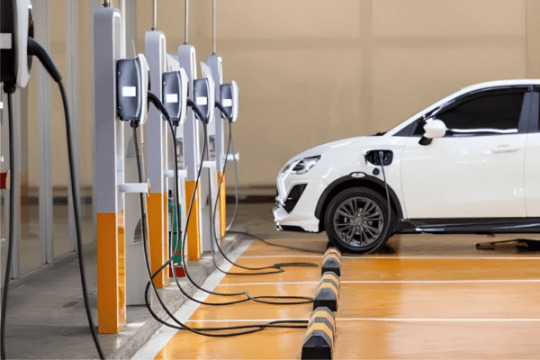
2. Motor Control Basics:
The power from both the ICE and the electric motor(s) is/are managed by sophisticated control algorithms in hybrid vehicles. The main objectives are increased performance, lower emissions, and better fuel economy.
The motor control system continuously tracks a number of variables, including the vehicle’s speed, the battery’s state of charge, the location of the accelerator pedal, and others.
3. Power Blending Strategies:
Parallel Hybrid: The ICE and the electric motor can operate the car either simultaneously or separately in a parallel hybrid. Depending on the operating conditions, the motor control system chooses which source to employ.
Series Hybrid: In a series hybrid, the electric motor directly propels the wheels while the internal combustion engine (ICE) serves as a generator to replenish the battery or supply extra power as required.
Power Split Hybrid: This type blends the output and efficiency of the ICE with the electric motor in a variety of ratios. A famous example of a power-split hybrid is the Toyota Prius.
4. Regenerative Braking:
Regenerative Braking is a technique used by hybrid automobiles to collect and store energy during acceleration. When used as a generator, the electric motor
5. Energy Management:
The energy transfer between the ICE, electric motor, and battery pack is managed by the motor control system. It chooses when to use the electric motor for immediate power and when to use the ICE for the best economy.
6. Performance Enhancement:
When necessary, hybrid motor control, sometimes known as “electric assist,” can raise power output to improve vehicle performance. This is especially helpful when accelerating and passing.
7. Fuel Efficiency and Emissions Reduction:
Fuel economy and emissions reduction are two of the main objectives of hybrid motor control. Hybrid vehicles can get higher fuel efficiency than conventional vehicles by maximizing the usage of electric power at low speeds and during stop-and-go traffic.
8. Plug-in Hybrids (PHEVs):
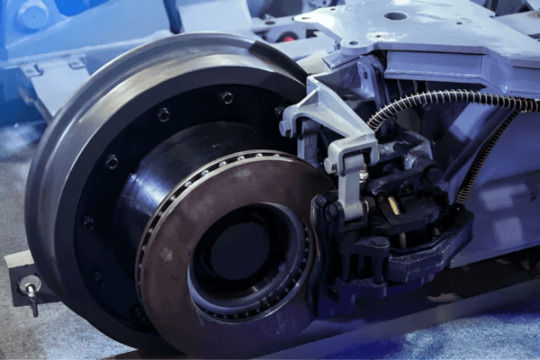
Advantages of Hybrid Vehicle Motor Control
When combining powertrains for performance, hybrid vehicle motor control systems have a number of benefits. These features help increase fuel economy, environmental benefits, and overall vehicle performance. Some of the main benefits are as follows:
1. Enhancing Fuel Efficiency:
In order to reduce fuel consumption, hybrid motor control makes the best use of both internal combustion engines and electric motors. In situations when conventional engines are less effective, such as slow speeds and stop-and-go traffic, it enables the vehicle to operate entirely on electric power.
2. Reduced Emissions:
Hybrid vehicles emit lower tailpipe emissions because they use an electric motor when the vehicle is moving slowly and under a light load. This results in a decrease in greenhouse gases and air pollutants, which helps to improve the quality of the air and reduce carbon footprints.
3. Enhanced Performance:
By exploiting the electric motor’s rapid torque, hybrid motor control systems can significantly improve performance. This electric assistance makes hybrid vehicles feel more responsive and strong, especially during acceleration and passing maneuvers.
4. Lower Operating Costs:
Due to its lower fuel consumption, less frequent need for brake maintenance, and potential tax breaks or rebates for environmentally friendly vehicles, hybrid cars frequently have cheaper operating expenses.
5. Future-Proofing:
Hybrid motor control systems are a versatile option for the future since they can be modified to work with new powertrains, such as more efficient internal combustion engines, hydrogen fuel cells, or cutting-edge battery technologies.
6. Energy Management:
In order to effectively distribute power between the engine, motor, and battery, hybrid motor control systems are used. By ensuring that power is accessible when needed, this improves the performance of the entire vehicle.
7. Adaptive Control:
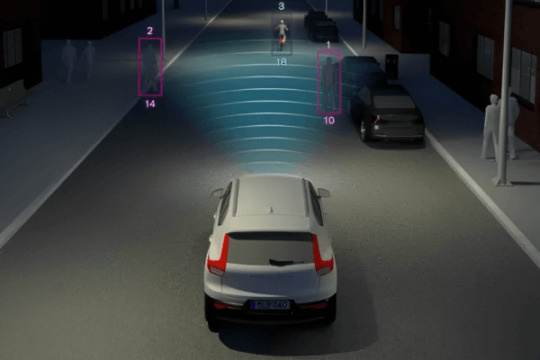
Disadvantages of Hybrid Vehicle Motor Control
While hybrid vehicle motor control systems have several benefits, combining powertrains for performance has certain drawbacks as well. These limitations may differ based on the particular hybrid technology and model, however, the following are some typical ones:
Cost and Complexity: Compared to conventional internal combustion engine vehicles, hybrid powertrains are more difficult to develop and expensive to maintain. Electric motors and batteries, for example, might push up the price of the vehicle’s initial purchase as well as its possible repair costs.
Production and Recycling Obstacles: The manufacture and disposal of hybrid vehicle parts, particularly batteries, can have an adverse effect on the environment. Battery recycling and disposal responsibly is a problem that needs to be solved.
Resale Value: Compared to non-hybrid automobiles, hybrid vehicles frequently have lower resale prices. This may be a drawback for purchasers who intend to sell their cars in a few years.
Limited Model Choice: Despite the increased popularity of hybrid technology, there are currently fewer hybrid models on the market than there are for conventional vehicles. Finding a hybrid that fits a certain set of preferences and requirements may be more difficult due to the limited availability.
Limited Towing capability: Compared to some conventional vehicles, hybrid vehicles, particularly smaller ones, may have a lower towing capability. For individuals who need the ability to tow, this restriction may be a drawback.
Upkeep Difficulty: Not many mechanics are qualified to operate hybrid automobiles, which require specialist upkeep. This could make maintaining the car more difficult and possibly more expensive.
Performance Trade-offs: Although electric help in hybrids can boost performance, their performance may fall short of those of high-performance internal combustion engine automobiles. For those who demand the best performance, hybrid vehicles may fall short.

Conclusion:
In conclusion, hybrid vehicle motor control is a critical aspect of modern automotive engineering, enabling the seamless blending of powertrains for enhanced performance, improved fuel efficiency, and reduced environmental impact. Hybrid vehicles represent a significant step forward in the evolution of the automobile industry, addressing the need for more sustainable transportation while providing a satisfying driving experience.
Ultimately, the choice between a hybrid vehicle and a traditional one depends on individual preferences, driving habits, environmental concerns, and infrastructure availability. Hybrid technology continues to evolve, with ongoing research and development aimed at addressing some of the disadvantages and expanding the benefits of this innovative approach to transportation. As the automotive industry moves toward greater sustainability, hybrid vehicle motor control systems will play a pivotal role in shaping the future of mobility.
#PredictiveMaintenance#HybridVehicle#Powertrains#dorleco#controlsystem#ADAS#eMobilityControls#stroke#automotive#controlunit#PowertrainControl#Anti-lock Braking System
0 notes